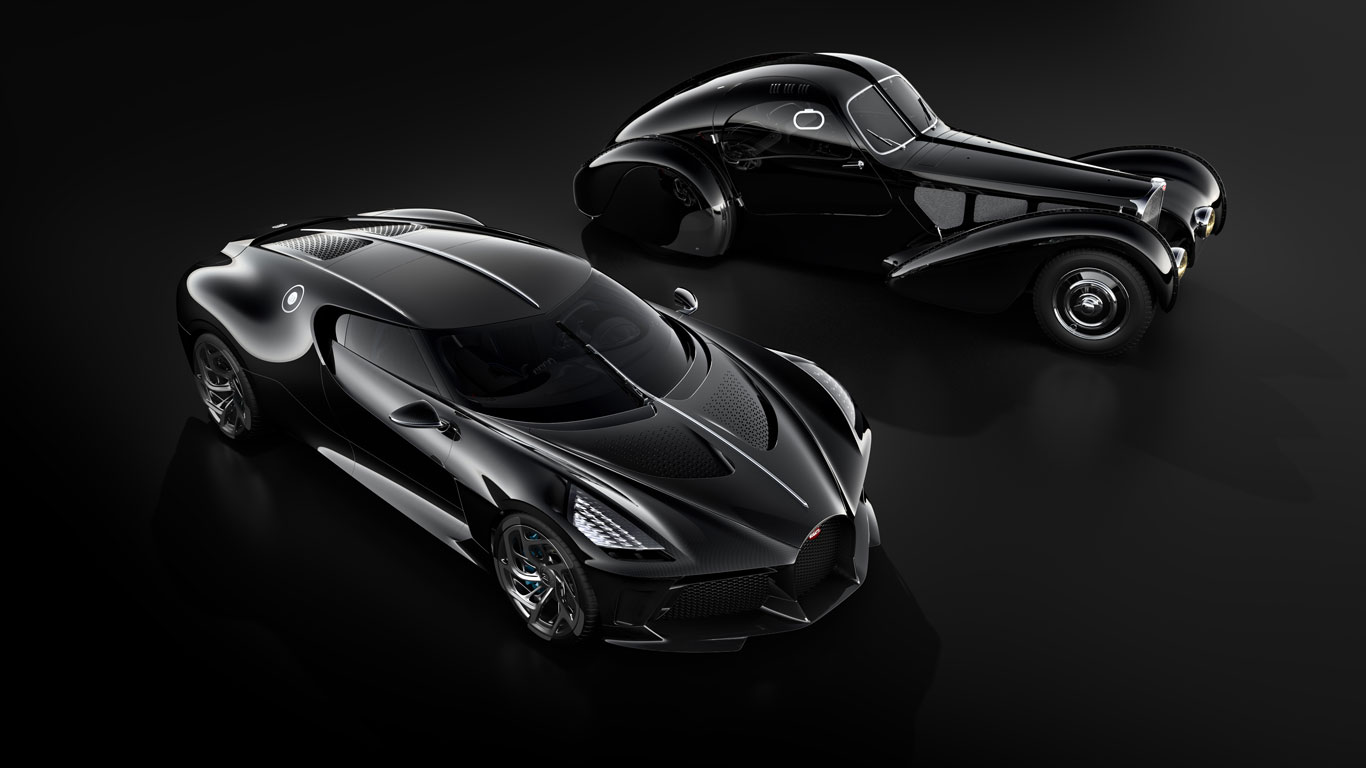
Bugatti hogged the limelight at the 2019 Geneva Motor Show with not one but two high-profile unveilings. Not content with launching the world’s most expensive new car, the brand also unveiled a special edition to celebrate its 110th anniversary.
With this in mind, we take a look back at some of the highlights of this famous automotive marque.
Ettore Bugatti
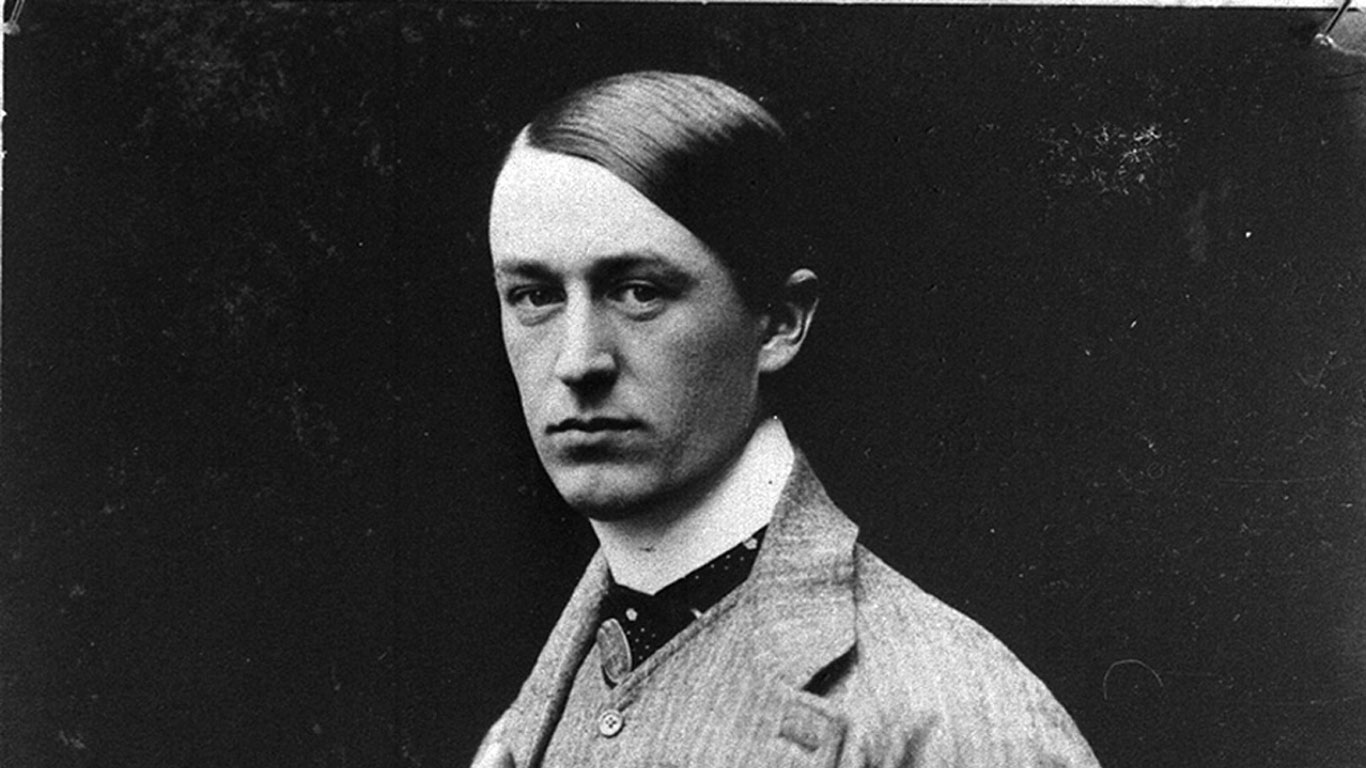
Ettore Arco Isidoro Bugatti was born in Milan on 15 September 1881 and was the oldest son of Carlo and Teresa Bugatti. His father, Carlo, was a renowned and award-winning artist and designer, especially famous for his furniture.
Having finished school, Ettore Bugatti became an apprentice at the bicycle manufacturer Prinetti & Stucchi. Just a year later, at the age of 17, he fitted an engine to a tricycle and experimented with a number of other models.
Ettore Bugatti
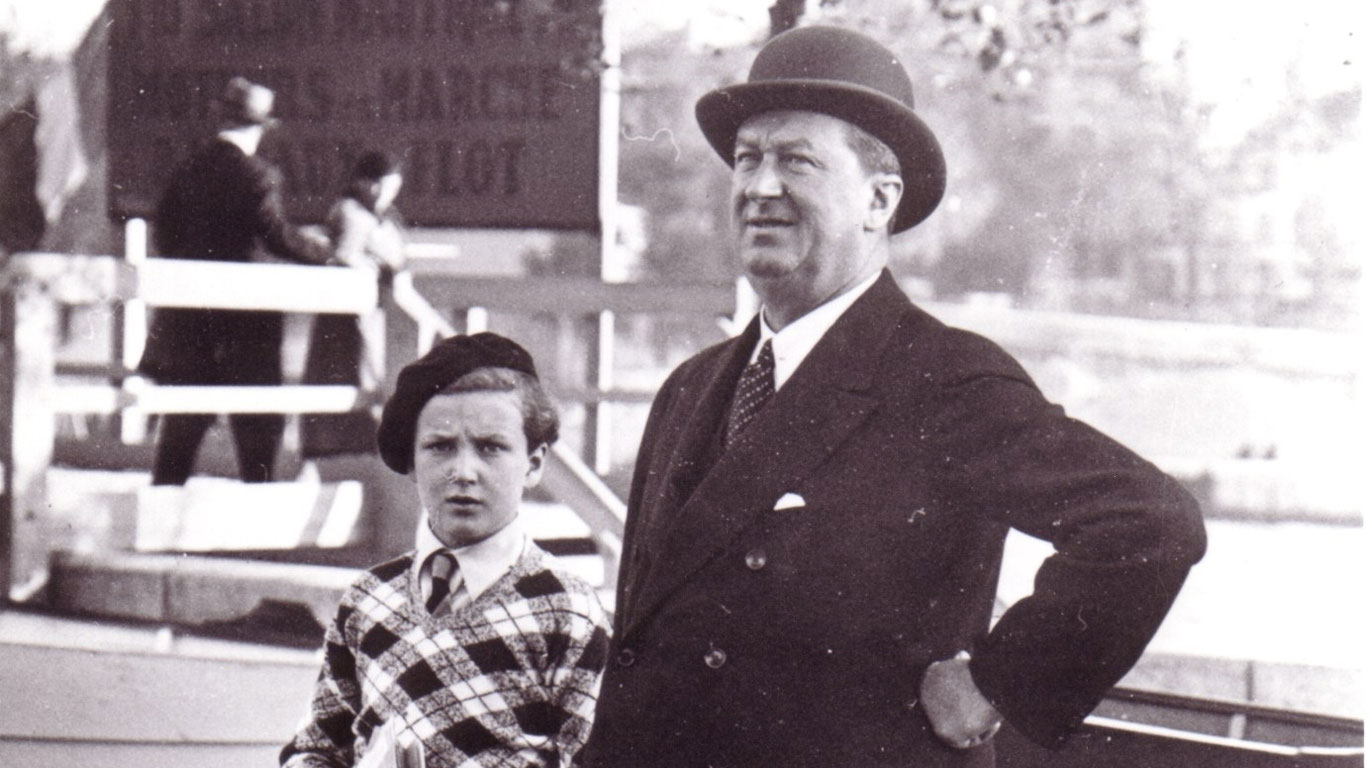
Another year passed before Ettore, pictured here later with one of his sons, Roland, built his first four-wheeled motor car. Named the Type 2 and produced with financial support from Count Guinelli, it won top prize at an exhibition and caught the eye of the famous De Dietrich family in Alsace.
In 1902, Ettore became head of technology at De Dietrich’s automobile division, where he developed a number of cars and entered many races. One such car was the Type 5: a chain-driven, upgraded version of the Type 2, with a 12.9-litre engine. Soon, Eugene de Dietrich grew tired of Bugatti’s focus on racing and his contract was terminated. His next role was to design a car with a four-cylinder engine for Emil Mathis in Strasbourg.
Jean Bugatti
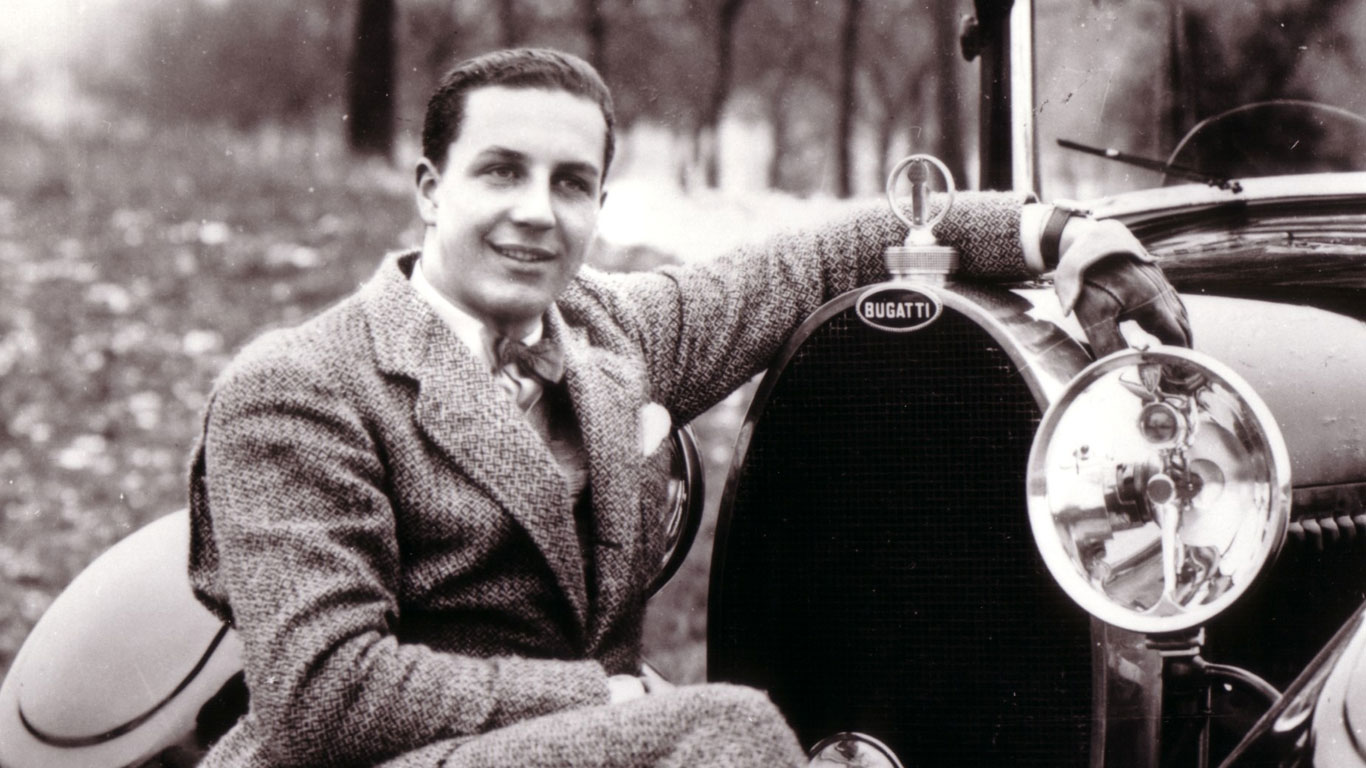
In 1907, Ettore Bugatti developed a 50hp car of his own and offered it to the Deutz engine factory in Cologne. The car was manufactured under licence and Bugatti became head of production. As a sideline, Bugatti was working on his own lightweight race car in his cellar.
Bugatti married in 1907 and, two years later, his wife Barbara gave birth to Jean (pictured), who would later follow in his father’s footsteps, designing a number of vehicles of his own. He also took charge of the Bugatti racing team from 1935.
Bugatti Type 13
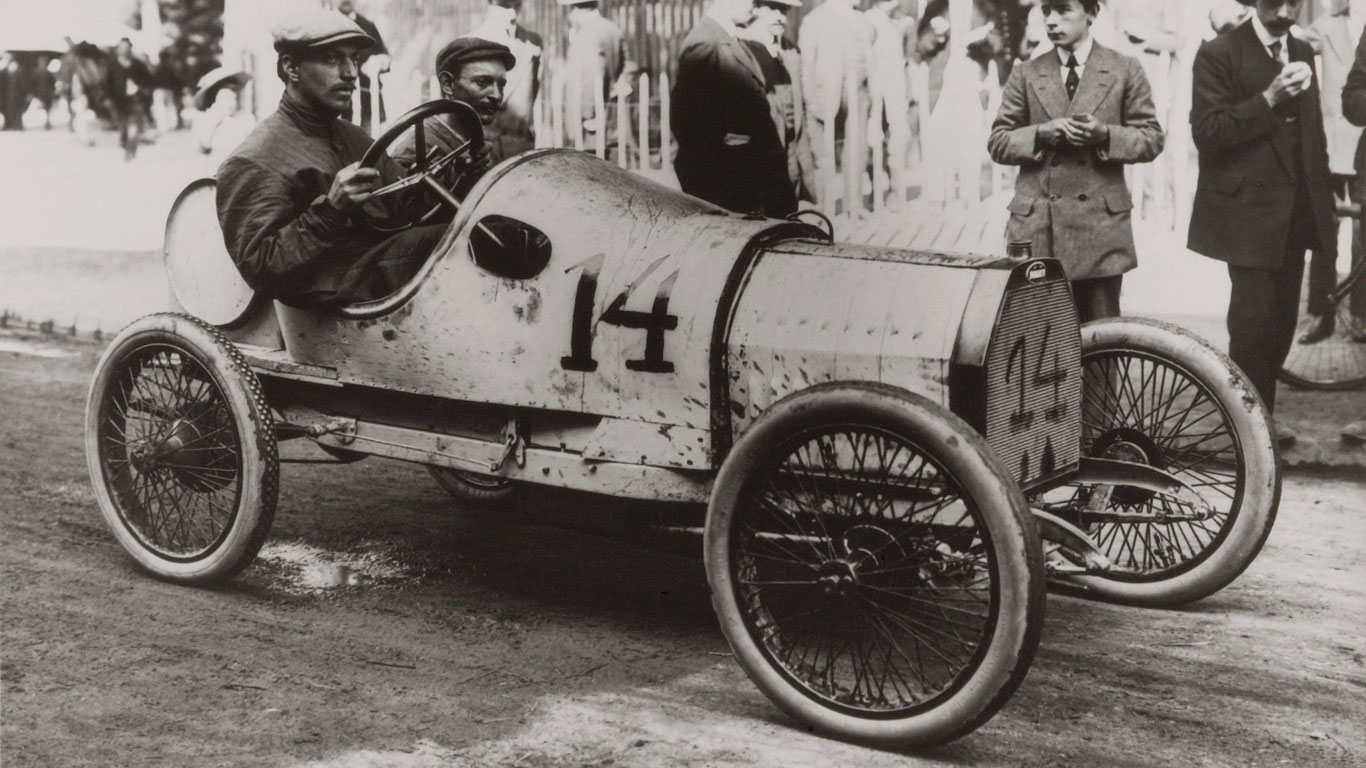
When Bugatti terminated his contract with Deutz in 1909, he took his severance pay and leased an old dyeworks building in Molsheim, Alsace. The company was called Automobiles Ettore Bugatti and would it become one of the most famous car brands in the world.
The Type 10 of 1910 was the first ‘Pur Sang’ (pureblood) car developed by Bugatti and was essentially a prototype of the Type 13 (pictured). Here we see Ernest Friderich at the 1911 French Grand Prix, where he finished second on his first attempt. The tiny eight-valve Type 13 achieved this remarkable result against a field of illustrious competitors, many with larger engines.
Bugatti Type 18
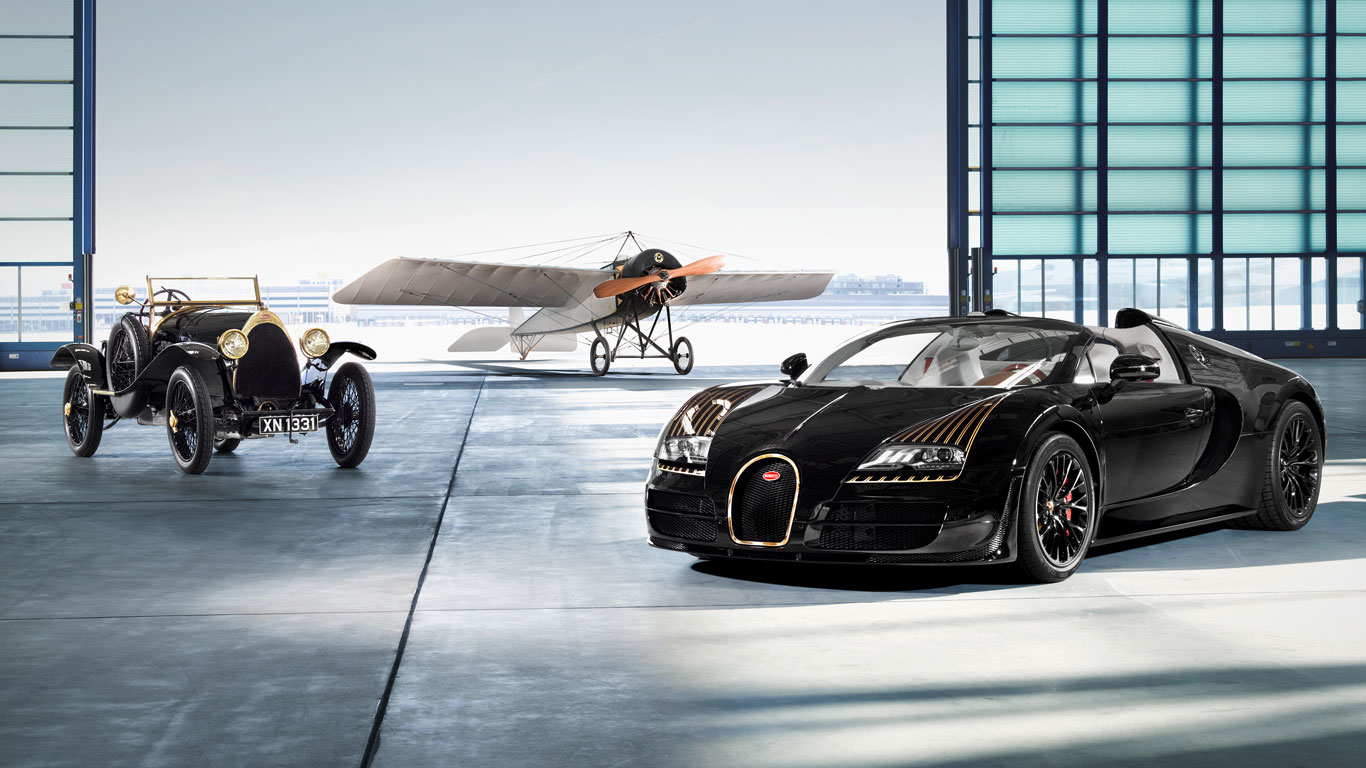
The Type 18 – nicknamed the ‘Black Bess’ – was one of the most important Bugattis of the pre-war era and one of the first street-legal race cars. With a top speed of 100mph it was one of the fastest vehicles in the world, which is why it attracted the attention of aviation pioneer, Roland Garros.
He was one of only seven customers for these 5.0-litre, 100hp road rockets. The Type 18 inspired the Bugatti Veyron 16.4 Grand Sport Vitesse ‘Black Bess’, which was limited to three models, each one with a price tag of €2.15 million.
Peugeot Bébé
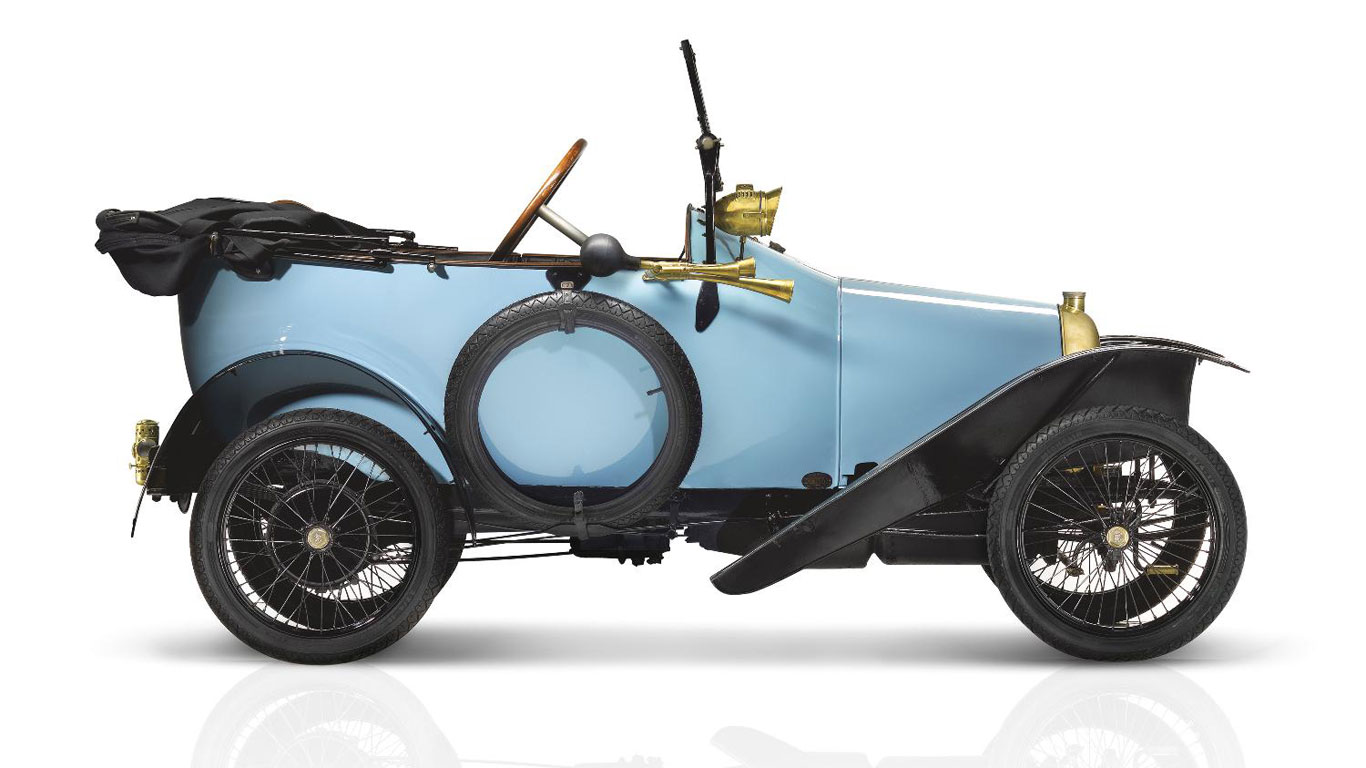
The Peugeot Bébé was developed by Bugatti but manufactured by Peugeot and was hugely a significant vehicle for both companies. For Bugatti it was its most successful model to date, while it was also the first Peugeot to break the 3,000-unit mark.
The little four-cylinder could reach a top speed of 60km/h (37mph) and was extremely economical to run.
Bugatti Type 13
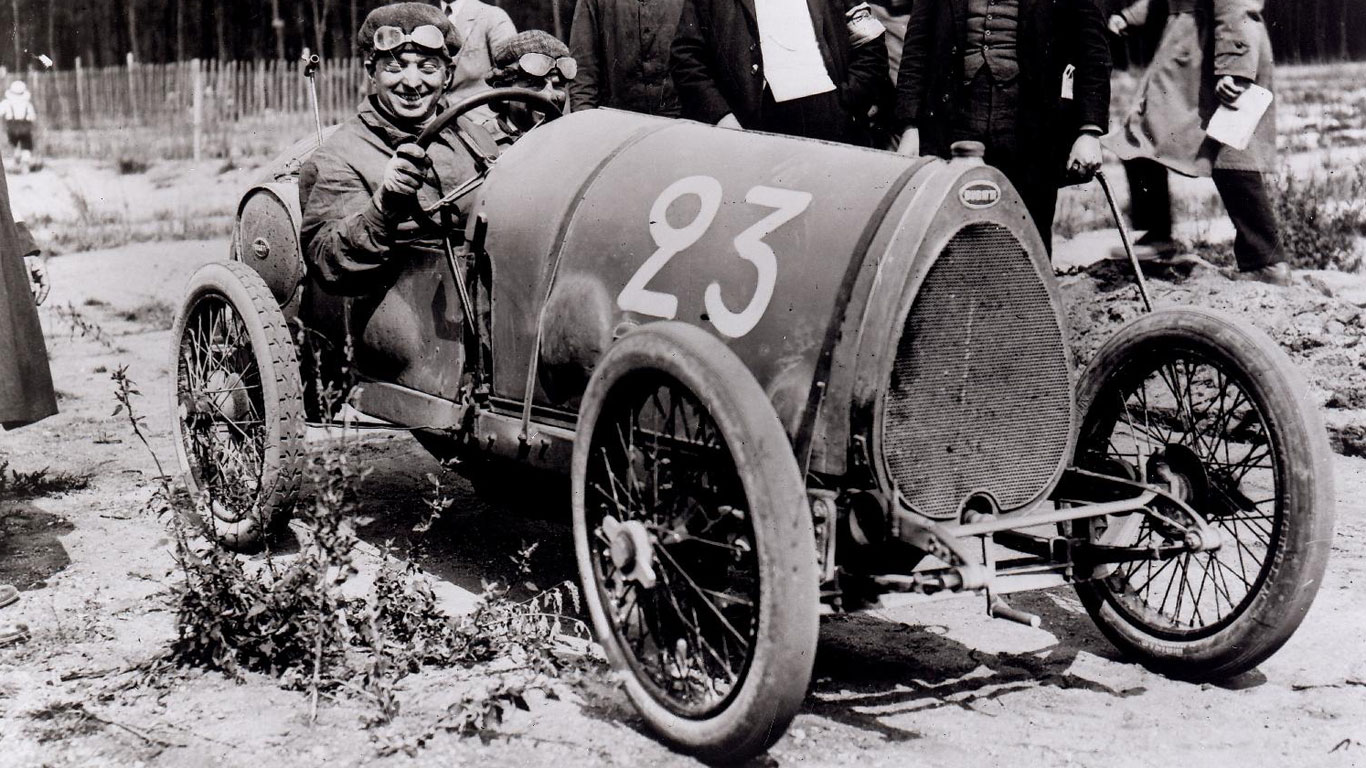
Bugatti’s first big win at the Grand Prix de la Sarthe in Le Mans came courtesy of the Type 13. Production began in 1914 and resumed in 1919 following the end of the First World War.
Various versions were produced, with the post-war Type 13 nicknamed ‘Brescia’ having dominated the 1921 Brescia Grand Prix, winning the top four spots.
Bugatti Type 29/30
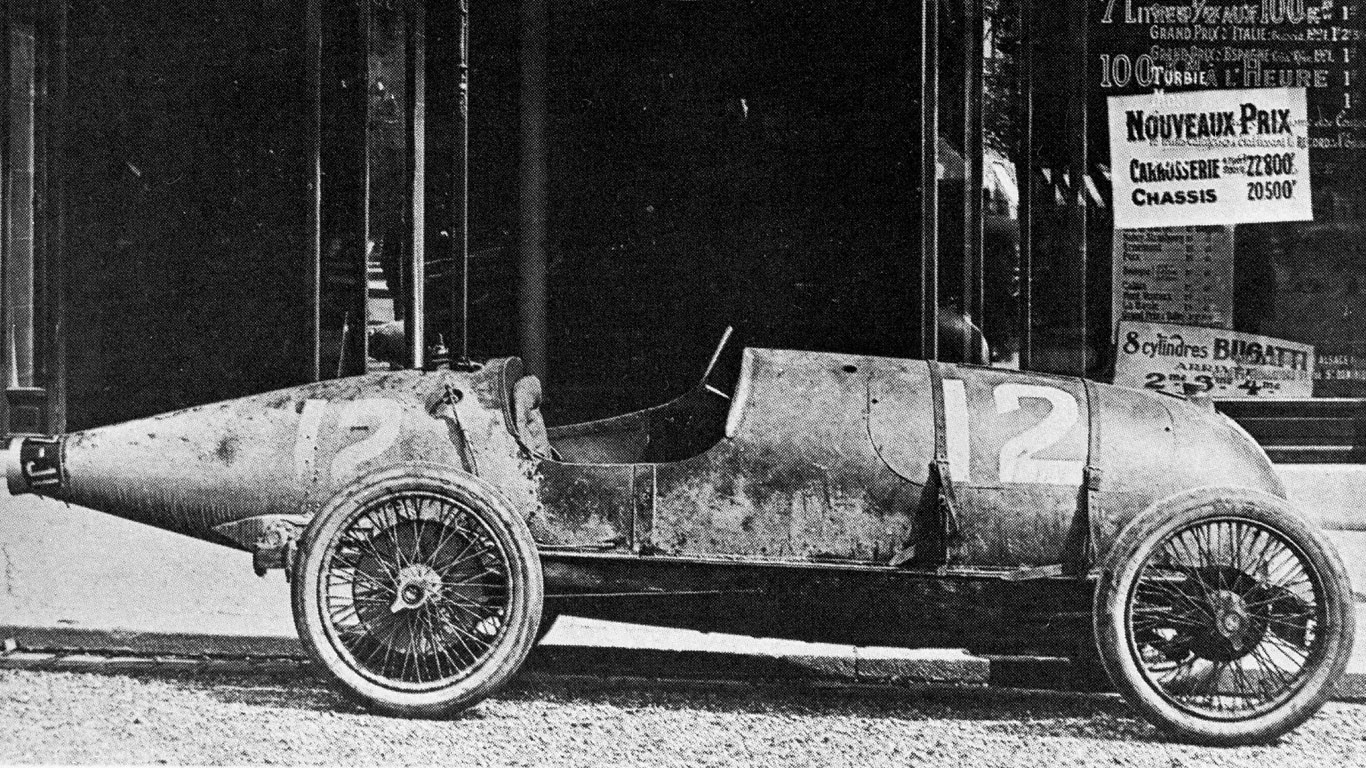
Although car production ceased during the First World War, the Molsheim factory wasn’t left idle. Bugatti developed several airplane engines for the French and American governments, with the proceeds enabling the company to resume automobile production in 1919. Indeed, the number of employees rose to more than 1,000.
In 1921, the Type 28 was built as a prototype, but the large number of patents applied for paved the way for all subsequent Bugatti developments. The following year, Bugatti launched the Type 29/30 (pictured), its first eight-cylinder race car. It achieved a power output of around 80hp and boasted a shape reminiscent of a cigar.
Bugatti Type 32
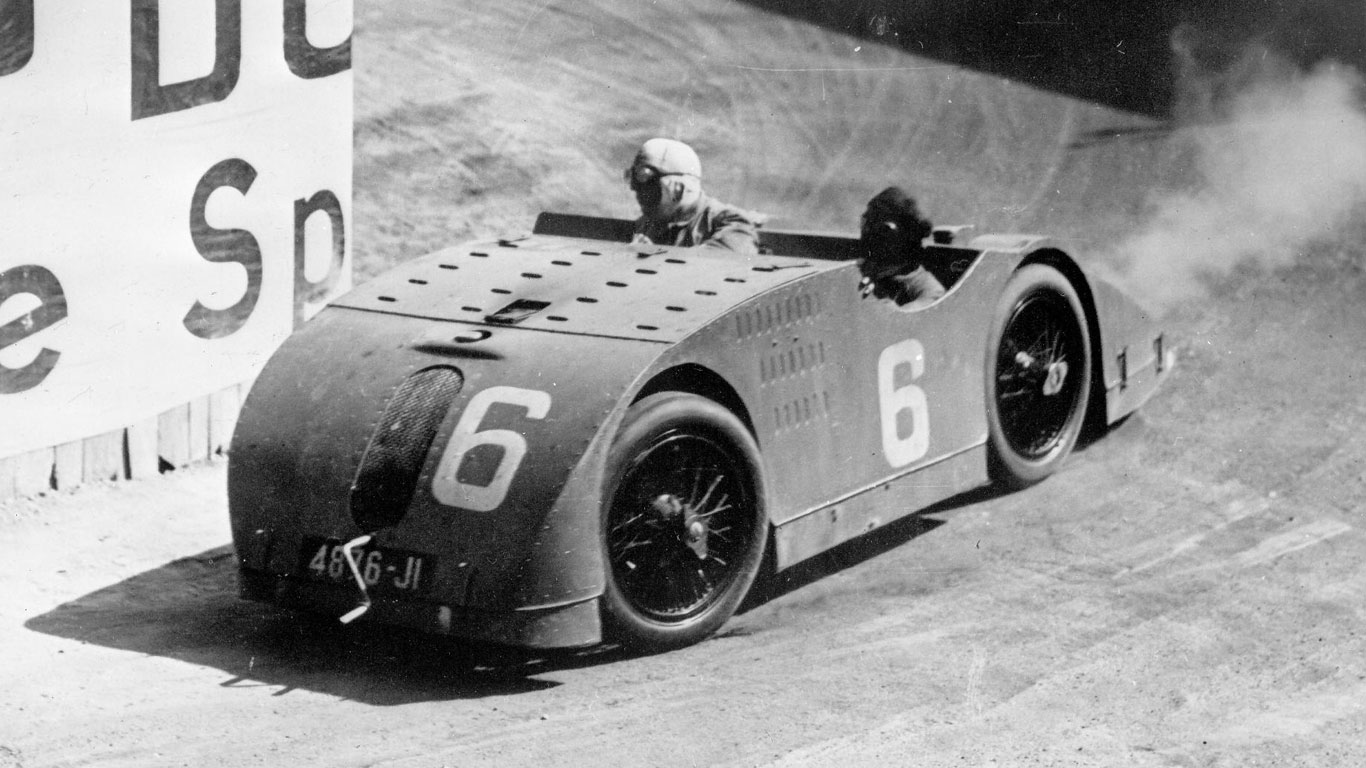
Bugatti’s first touring car, the Type 30, arrived in 1922 and some 600 units were built between 1922 and 1926. A year later, the revolutionary Type 32 arrived (pictured), which featured a bodyshell with a wing-shaped cross-section. Unfortunately, it was a tricky car to drive, while the shape generated lift rather than downforce.
It was nicknamed the ‘Tank’ thanks to its resemblance to the tanks used in the First World War and it introduced the concept of aerodynamics to motorsport. Although it wasn’t a successful racing car, it did manage a third place at the 1923 French Grand Prix.
Bugatti Type 35
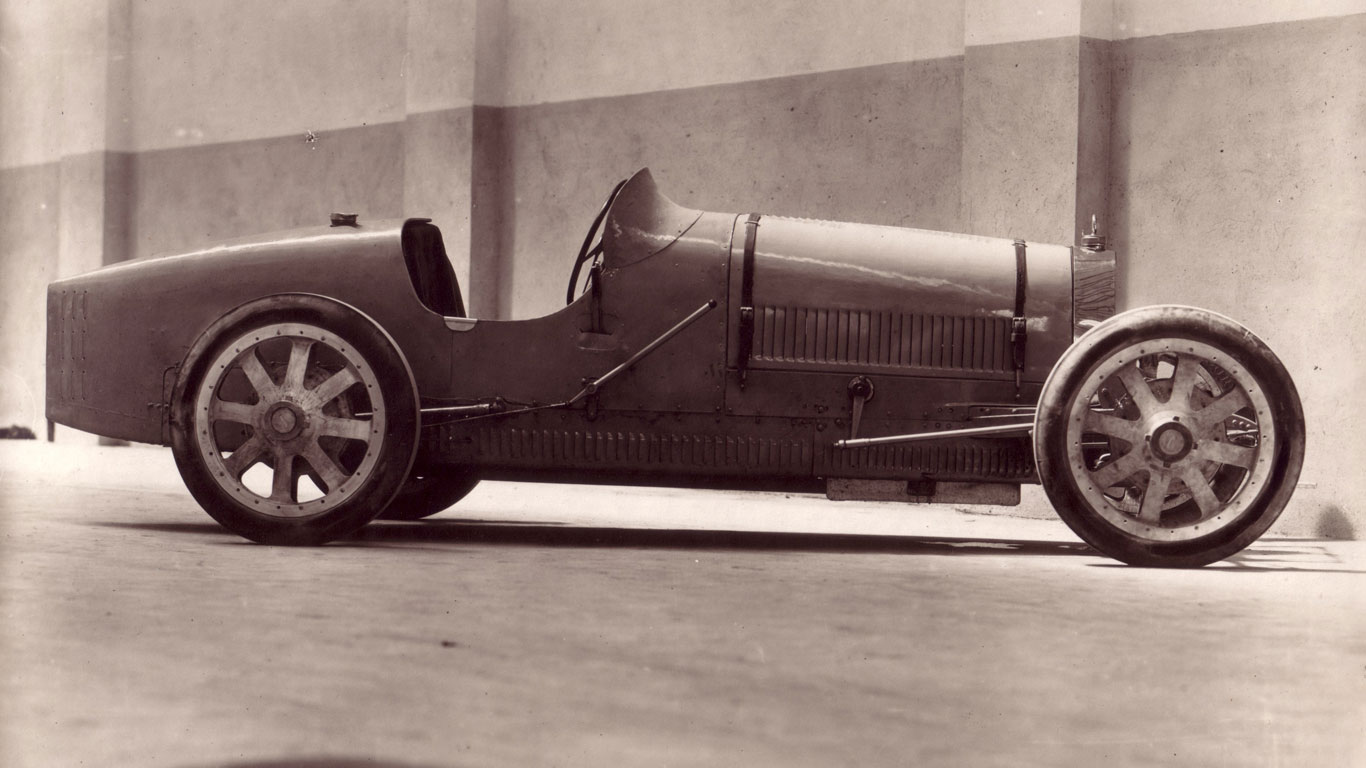
The Veyron and Chiron might be Bugatti’s pin-up models of today, but they owe a great deal to the legendary Type 35. It arrived in 1924 and kickstarted the golden age of Bugatti, securing more than 2,000 race victories over a 10-year period. It was, without question, the most successful race car the world had ever seen. It picked up five consecutive wins at the Targa Florio alone.
It was also effortlessly beautiful, complete with the now iconic ‘horseshoe’ radiator grille and spoked aluminium wheels. Later, in 1926, the hugely successful Type 40 arrived, along with the news that Bugatti would begin offering factory bodyshells from its factory in Molsheim.
Bugatti Type 41 Royale
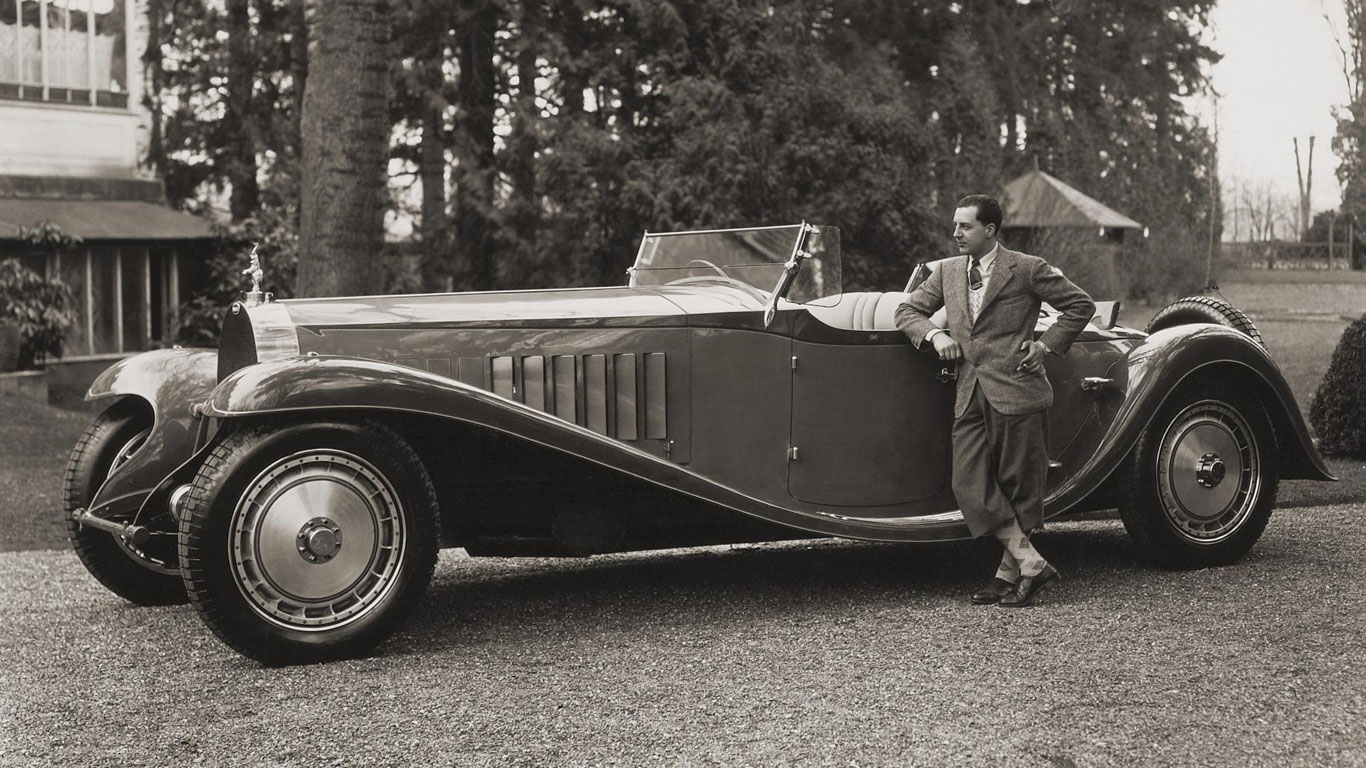
If the Type 35 should go down in history as one of the world’s most successful race cars, the Type 41 Royale is arguably one of the most extravagant. In both size and displacement it was huge – a 15ft wheelbase and 12.7-litre eight-cylinder engine – but it arrived at the wrong time.
As the Great Depression shook the world, Bugatti was left with a huge problem. Of the six built, only three were sold to customers and the Royale nearly bankrupted the firm. The first Royale built for a customer sold in 1932 for an incredible 700,000 francs.
Bugatti Type 50
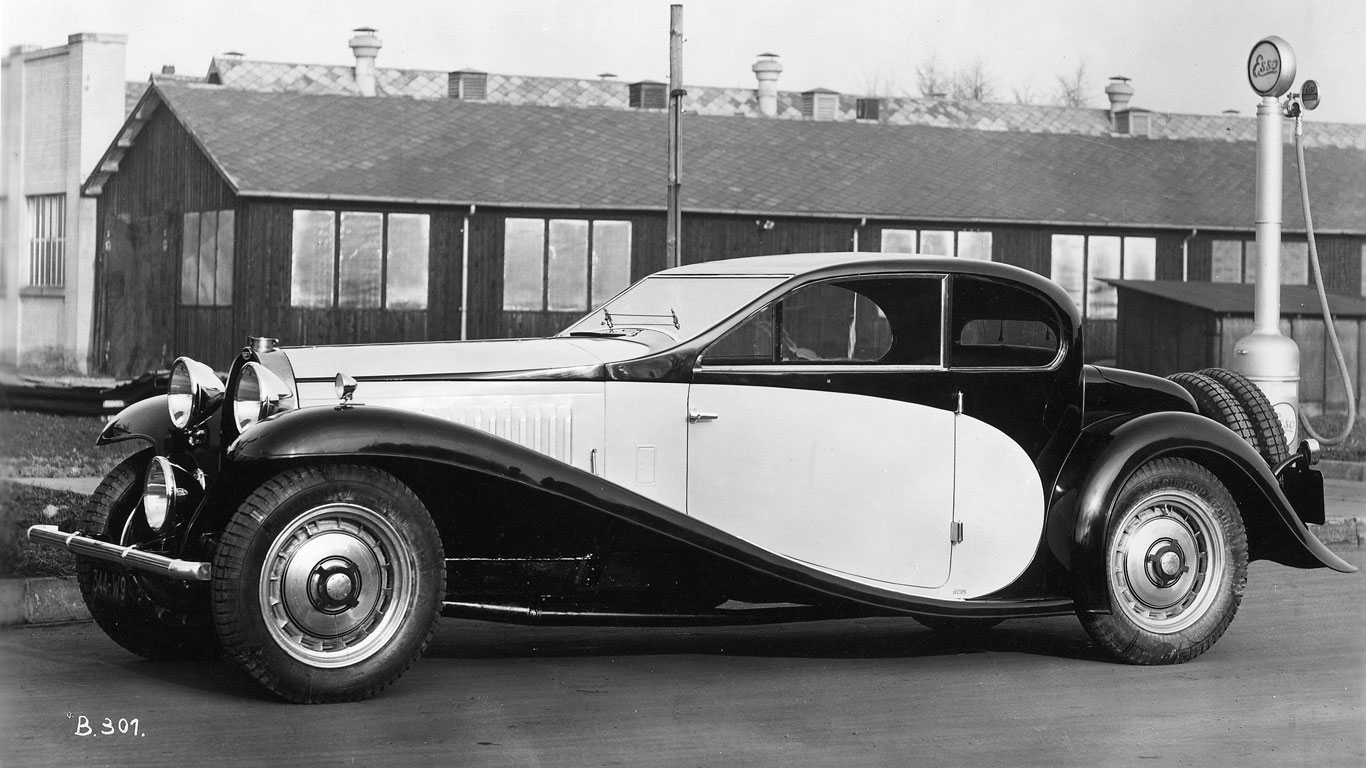
Meanwhile, life went on in Molsheim. The fourth and fifth Targa Florio victories were secured in 1928 and 1929, while William Grover drove a T35B to victory in the 1929 Monaco Grand Prix – the first time Bugatti had triumphed at the famous street circuit.
The Type 50 (pictured) arrived in 1930 and was essentially a sporting coupe version of the Type 46. It was significantly more powerful, boasting 225hp at 4,000rpm, rather than the 160hp at 3,500rpm offered by the 46S.
Bugatti Type 51
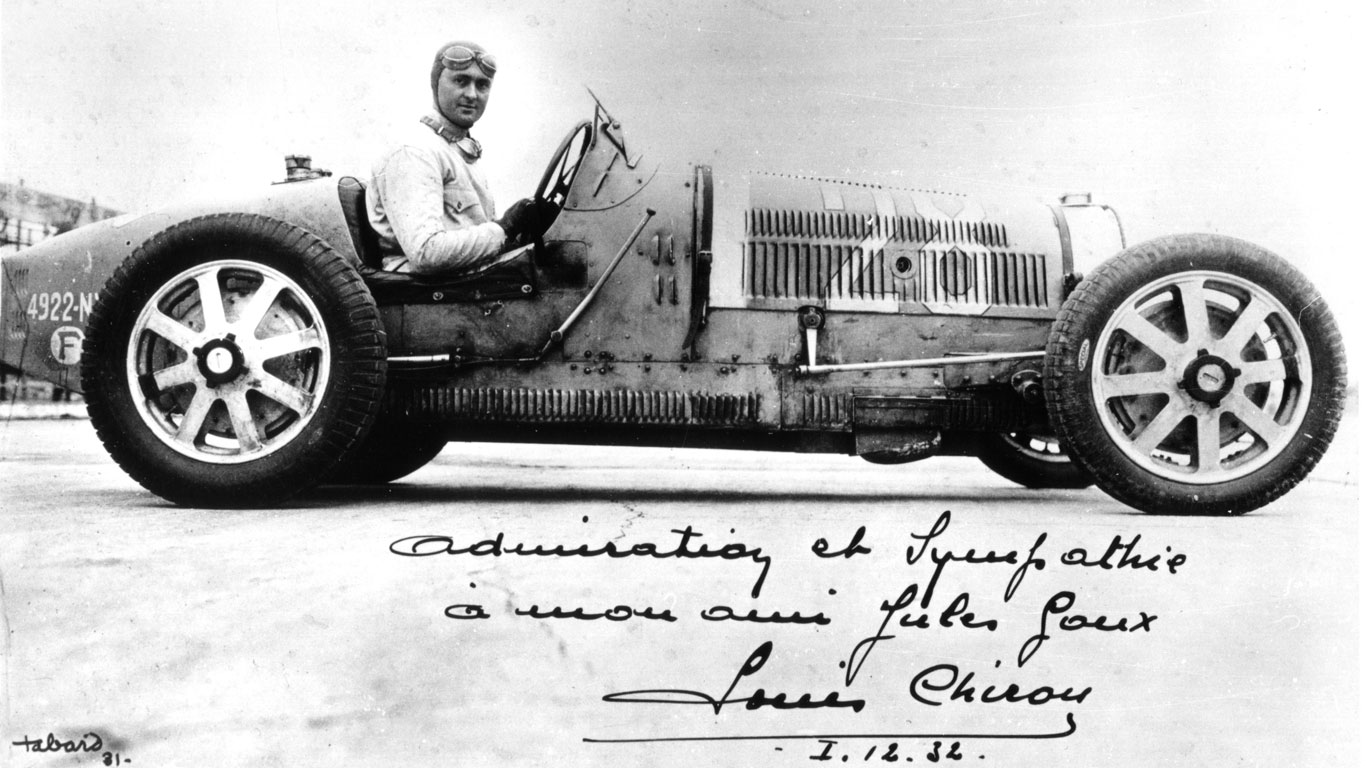
How do you follow one of the most successful race cars of all-time? A tough ask and in reality the Type 51 wasn’t up to the challenge. It arrived in 1931 and the signs were good when Louis Chiron drove car number 22 to victory at the 1931 Monaco Grand Prix. But it proved to be a false dawn and the Type 51 was unable to emulate the success of the Type 35.
Also in 1931, Bugatti made its factory team debut at Le Mans. The Type 50s driven by Chiron and Varzi, Divo and Bouriat, and Conelli and Rost were painted black following a disagreement between Ettore Bugatti and the motorsport authorities. Bugatti refused to race in French Racing Blue.
Bugatti Type 55
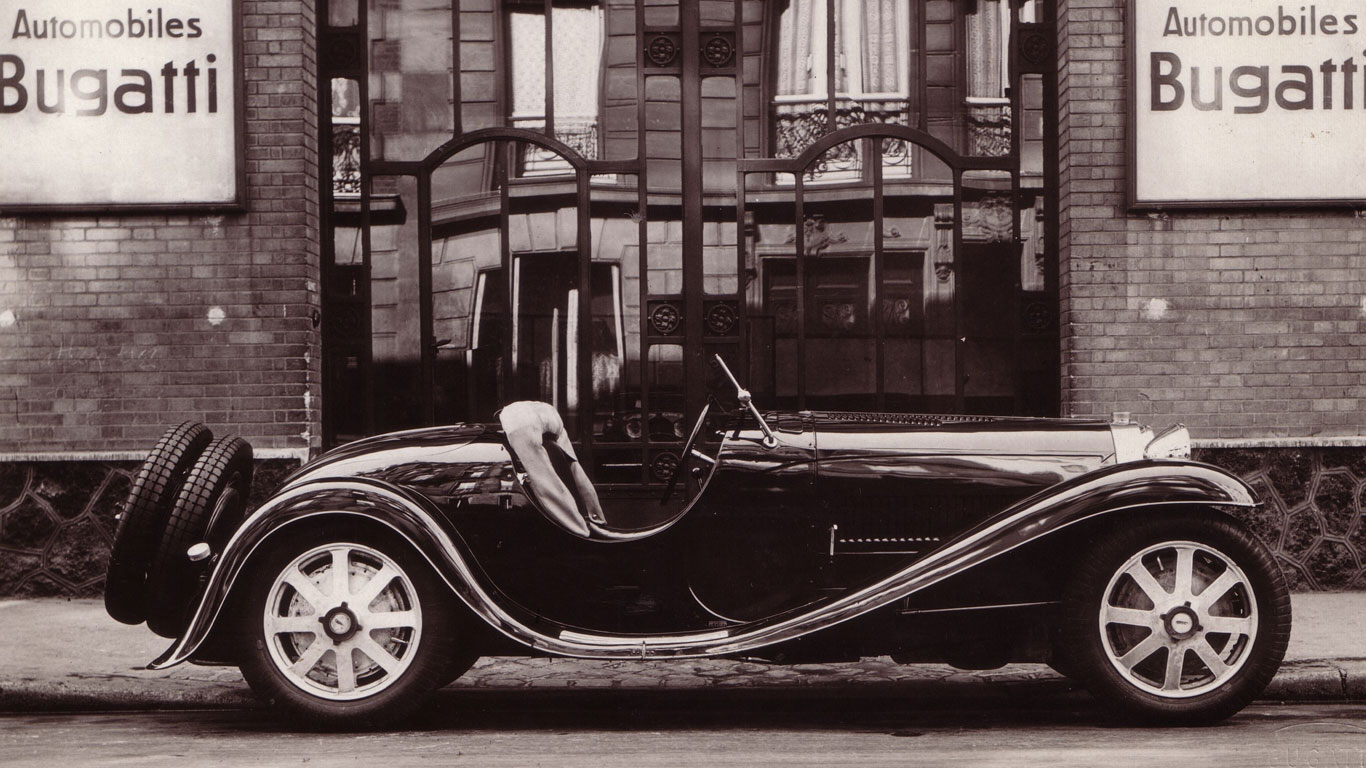
The achingly beautiful Type 55 was designed by Jean Bugatti and was essentially a touring car with a Grand Prix engine. It used the 2.3-litre supercharged engine from the Type 51 and could be ordered in both two-seat roadster and coupe ‘faux cabriolet’ forms.
A total of 38 units were built between 1931 and 1935.
Bugatti Type 53
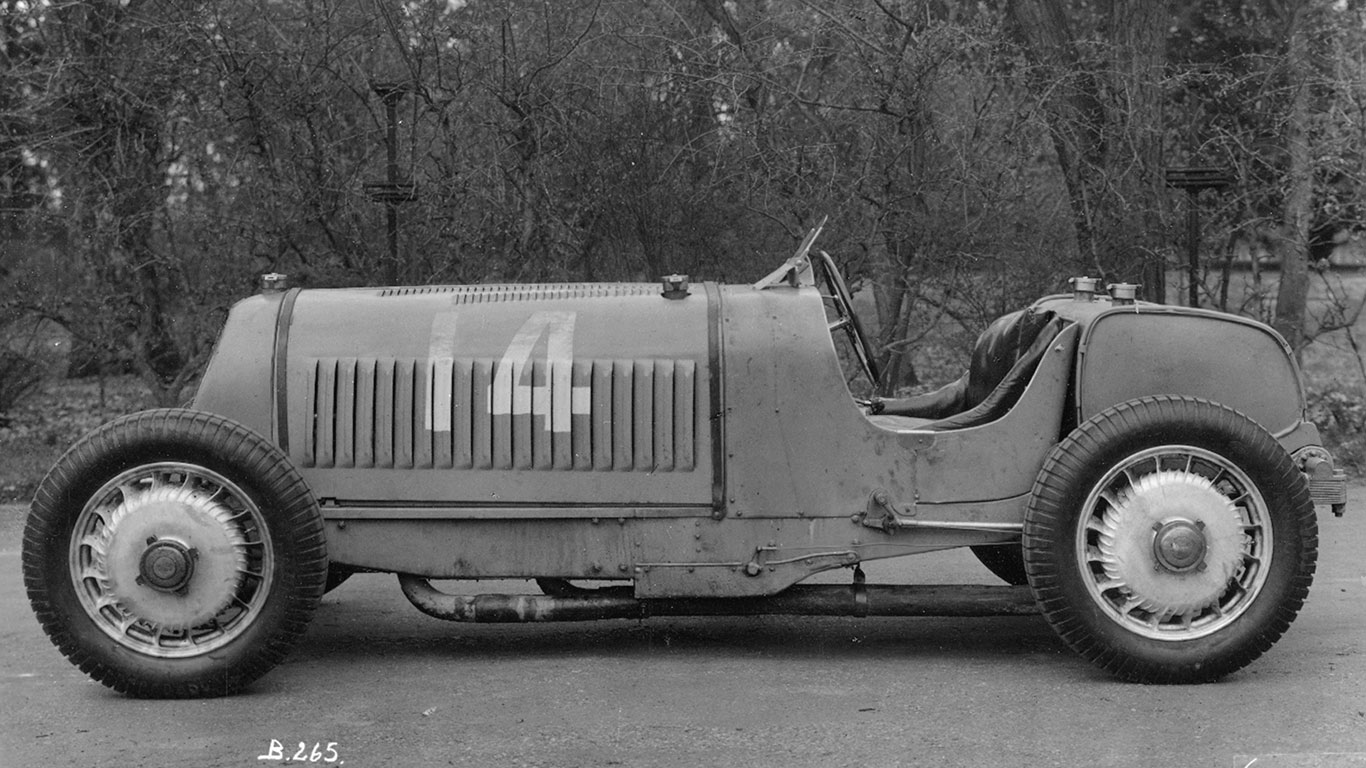
The Veyron and Chiron send power to all four wheels, but up until 1932 Bugatti had never experimented with four-wheel drive. The Type 53 Four-Wheel Drive was the first and only car of its kind designed by Ettore Bugatti.
It’s a little known fact that Ettore Bugatti also experimented with electric power. The Type 56 used the electric car to drive around the Molsheim factory. Although it was never intended for production, it is believed that six were built.
Bugatti Type 59
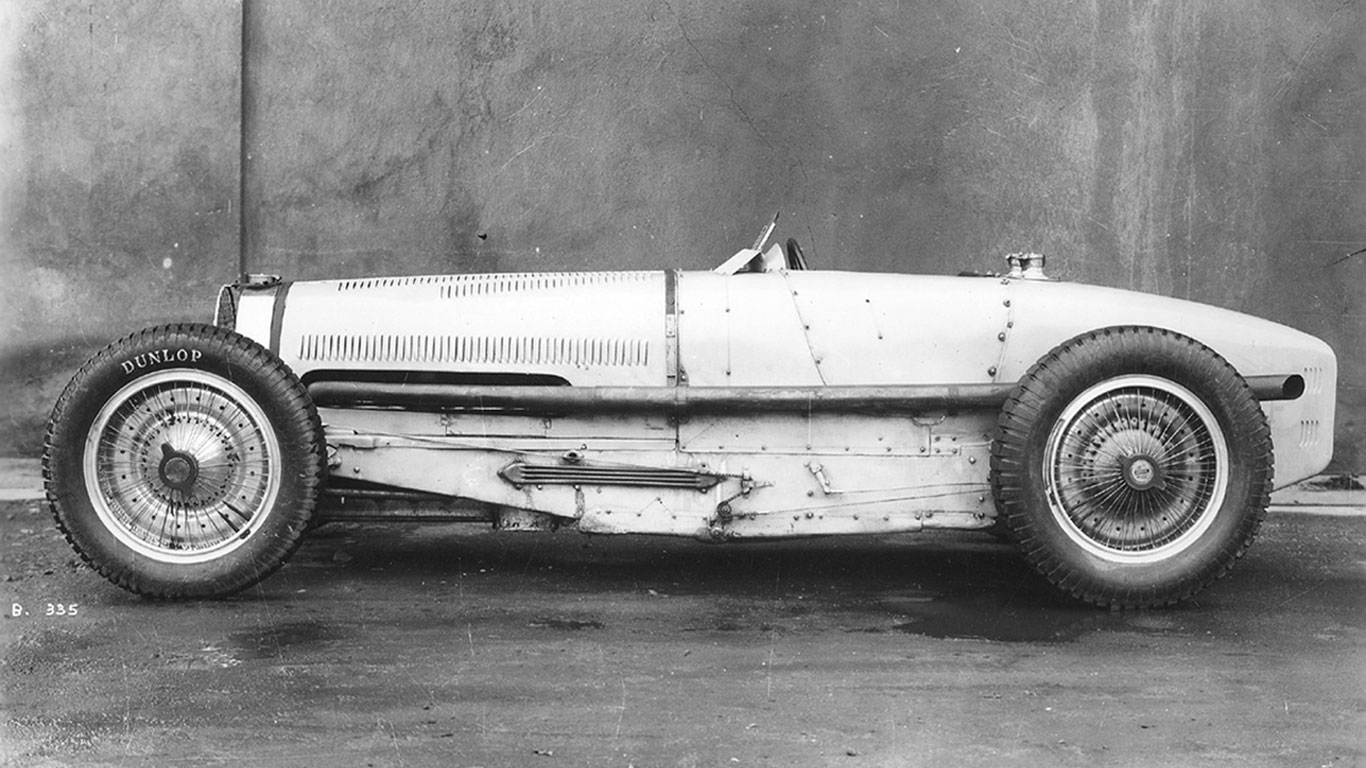
In 1932, Jean Bugatti took over as head of the racing team and design division. He designed many new models, including the Type 59 as seen here. In 1976, Motor Sport magazine claimed that to many people this is the most beautiful race car built by Bugatti and it’s certainly an elegant machine.
By now, Ettore was losing interest in racing and the Bugatti team was no longer competitive. The Type 59 used an enlarged version of the 3.3-litre engine found in the Type 57 and was Bugatti’s final race car of the 1930s. By Bugatti’s own admission, the Type 59 was technically outclassed.
Bugatti Type 57
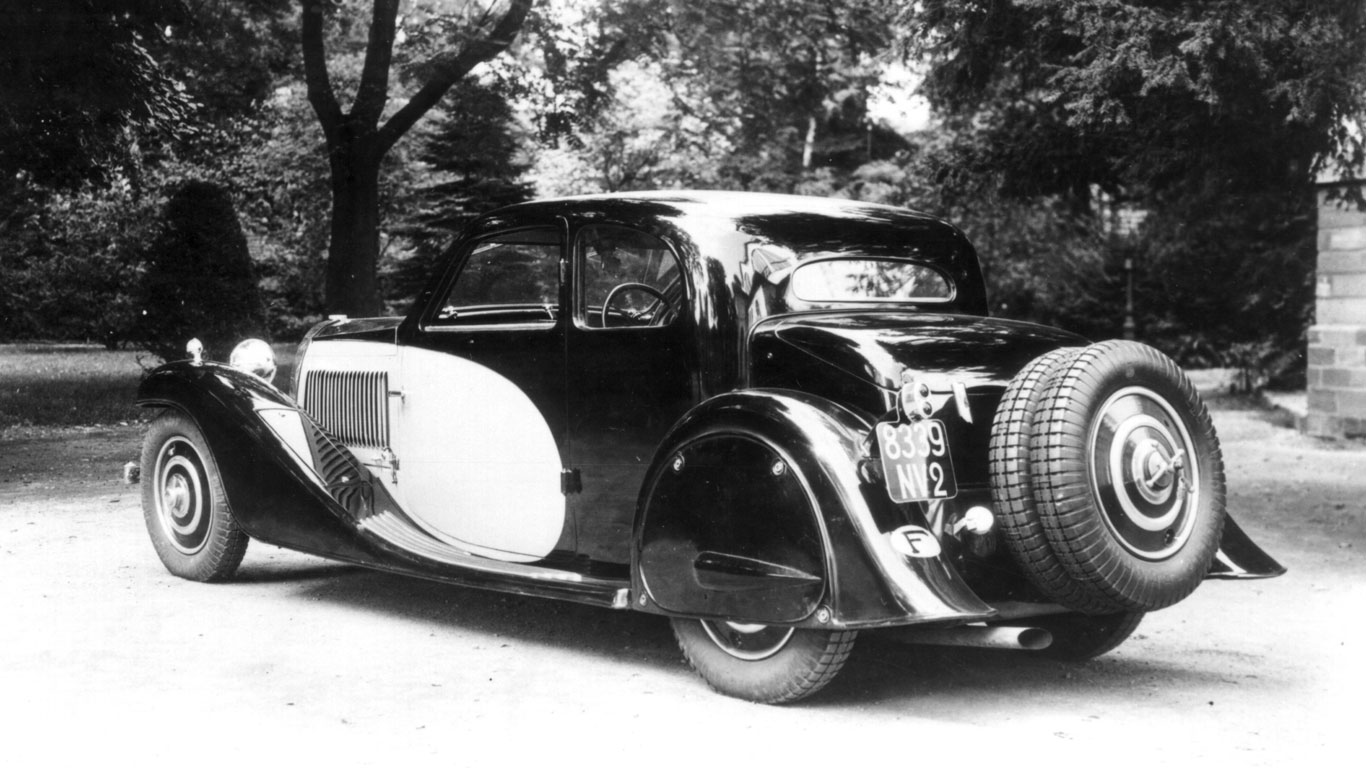
But if Bugatti’s influence within motorsport was dwindling, it was becoming a major force in the luxury sector. The iconic Type 57 was designed by Jean Bugatti and arrived at the 1934 Paris Motor Show.
For the first time, a Bugatti could be ordered in C, S and SC variants from the factory. Approximately 950 units were built between 1934 and 1939.
Bugatti Type 57S and 57SC
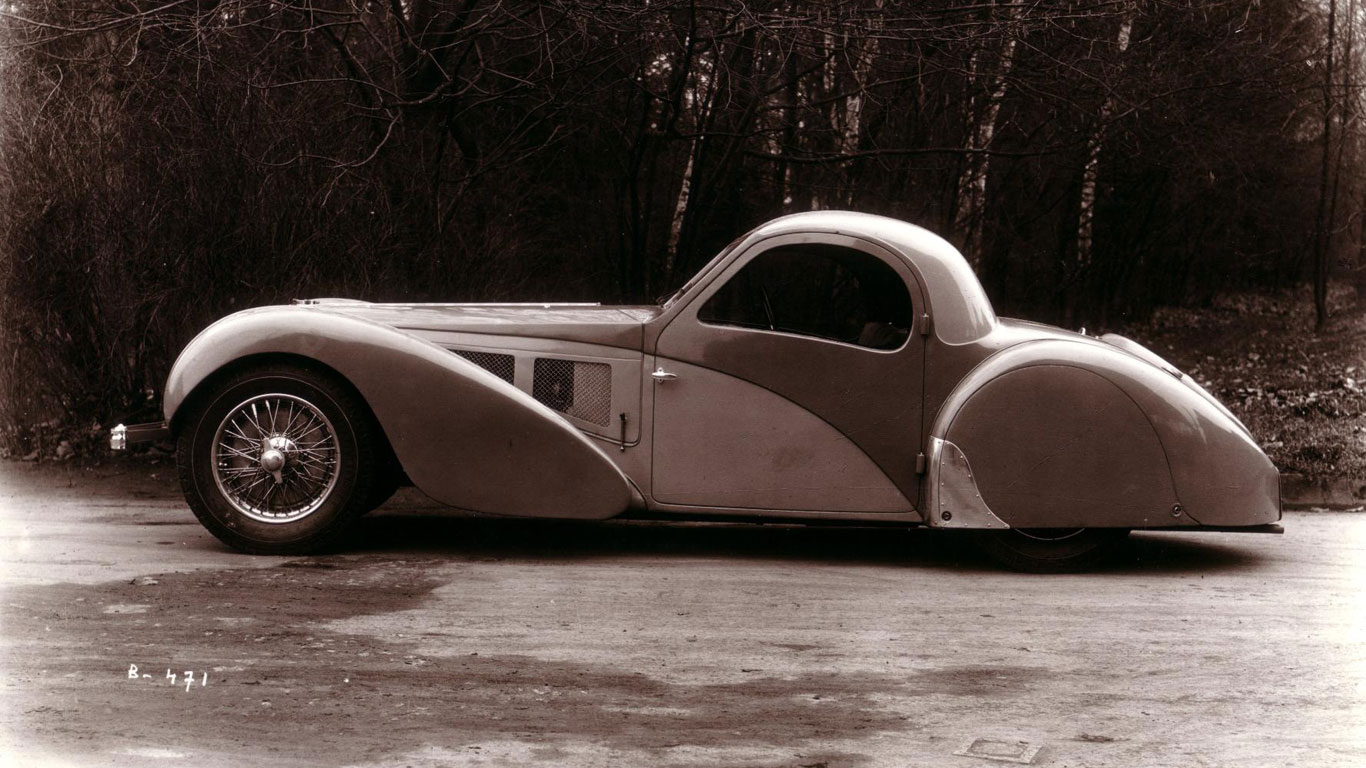
Of all the Type 57 models, the S and SC are the most desirable. S stood for ‘Surbaissé’ (lowered), while C stood for ‘Compressor’, denoting Bugatti’s supercharger.
The 57S’s chassis was 32cm shorter than the Type 57 with a ground clearance of just 12cm. Power was increased too, with the S achieving 170hp, 35hp more than the standard Type 57. The Atalante (pictured) was based on the S chassis but with a single-piece windscreen and no fin. It is regarded as one of Jean Bugatti’s finest creations.
Bugatti Type 57G
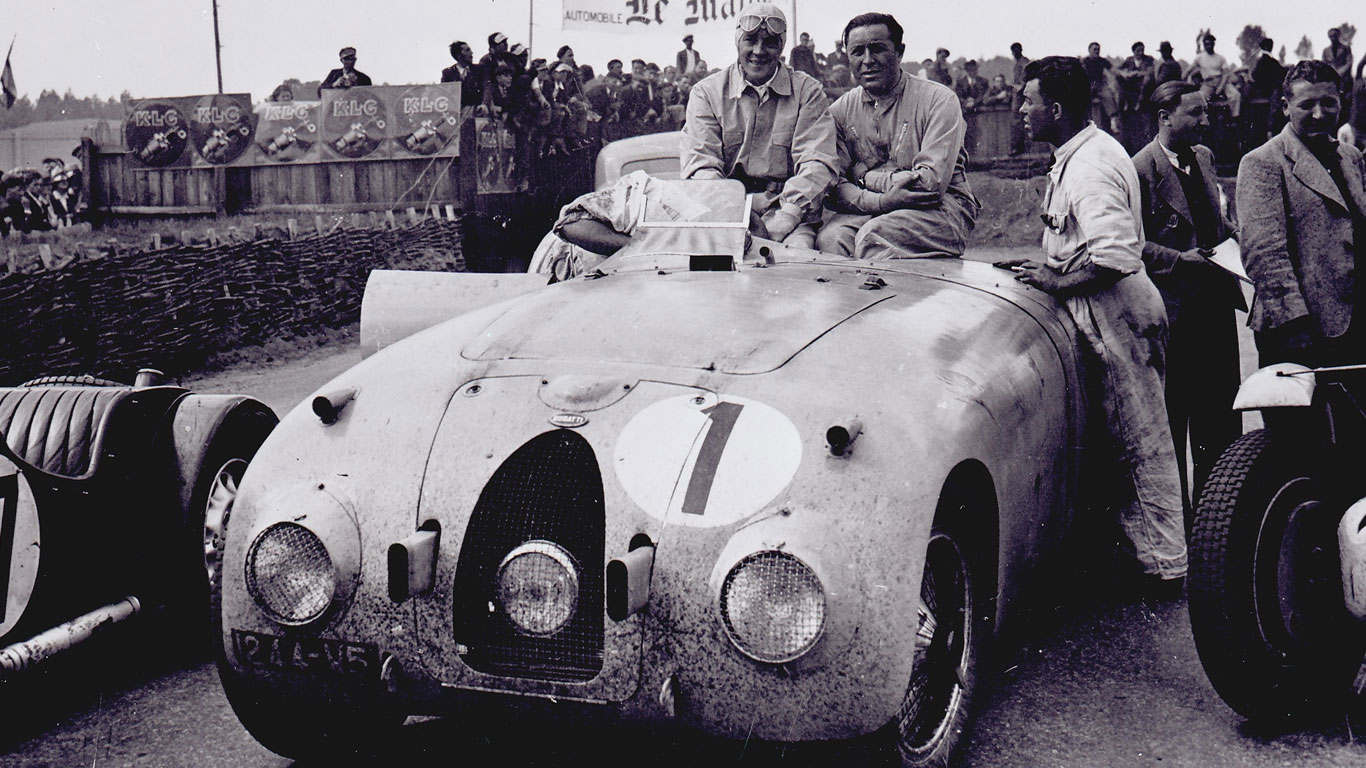
And now for something completely different… The 57G ‘Tank’ was the only Bugatti race car to achieve multiple successes in the latter half of the 1930s, with victories at Le Mans and the French Grand Prix.
At the 1937 Le Mans, Jean-Pierre Wimille set a new lap record speed of 148.98km/h and broke the distance record in the 23rd hour, securing Bugatti’s first Le Mans victory in the process. Three 57Gs were built and only one is thought to have survived.
Bugatti Autorail
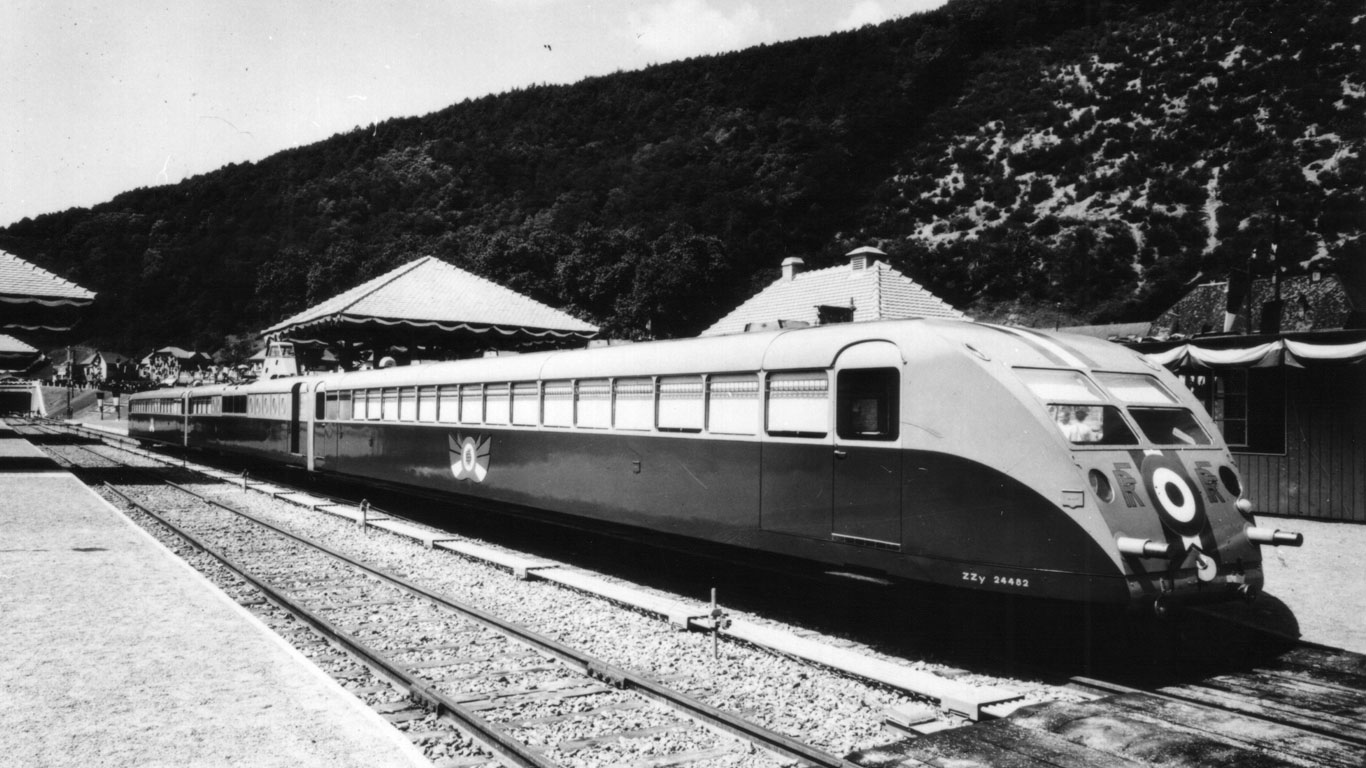
The huge 12.5-litre engine from the Bugatti Royale found an unlikely new home in the form of the Bugatti Autorail of 1932. Bugatti offered to build high-speed train for the French national rail authority in 1931 and won the tender in the face of fierce competition.
Jean Bugatti drove the Autorail on its official test runs at Gallardon, before setting a new record speed of 166km/h on a 24km stretch of track near Le Mans. In 1934, the Autorail achieved a speed of 192km/h over 6km.
Bugatti Type 101
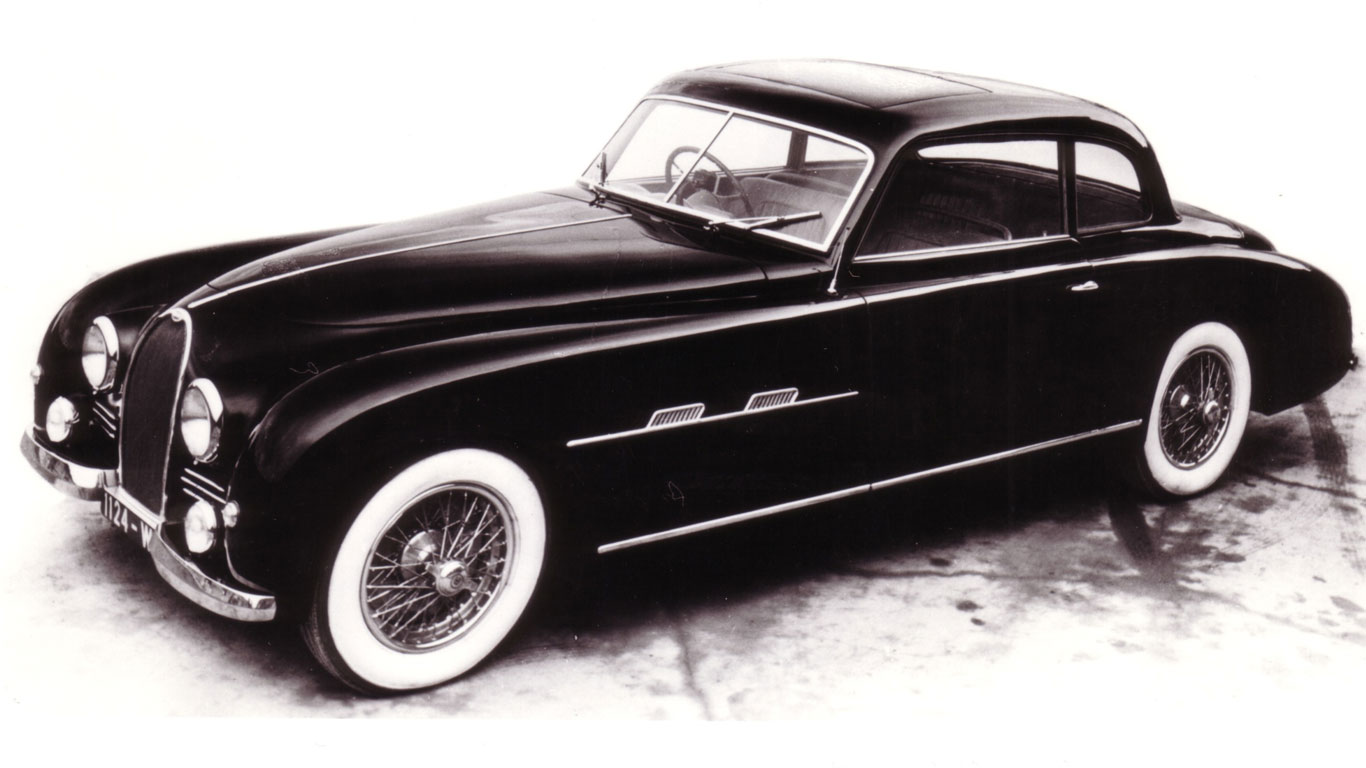
The end of the 1930s signalled the end of the boom years for Bugatti. In 1936, a strike at the Molsheim factory placed a wedge between Ettore Bugatti and the workers, with the boss deciding to work almost exclusively in Paris and reducing the pay of his employees in Alsace.
Three years later, Jean Bugatti died during a test drive, while a year later, the German occupying forces instructed Ettore Bugatti to sell the factory to Hans Trippel for 150 million francs. Ettore died in 1947, with Pierre Marco put in charge. The Type 101 (pictured) was merely a Type 57 with a few modifications.
Bugatti Type 251
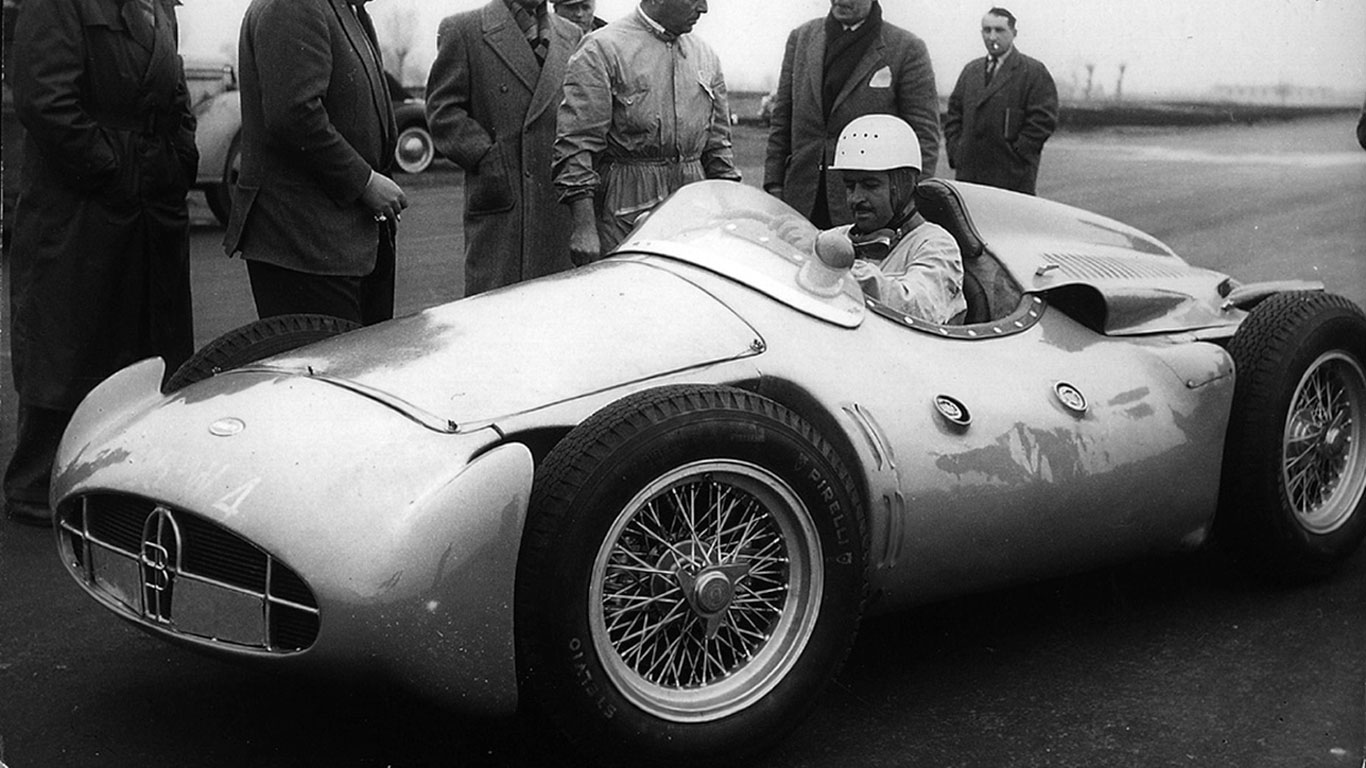
The Type 251 of 1955 represented the last hurrah for ‘old’ Bugatti. By now, the company was focusing on maintenance for old vehicles and engines for the military, rendering the Type 251 little more than a footnote at the end of an exceptional book.
The Gioacchino Colombo-designed Type 251 was entered in the 1956 French Grand Prix but was forced to retire after 18 laps. Bugatti ceased production in 1956, by which time it had built approximately 7,900 cars. The famous brand would sleep for many years…
Period of change
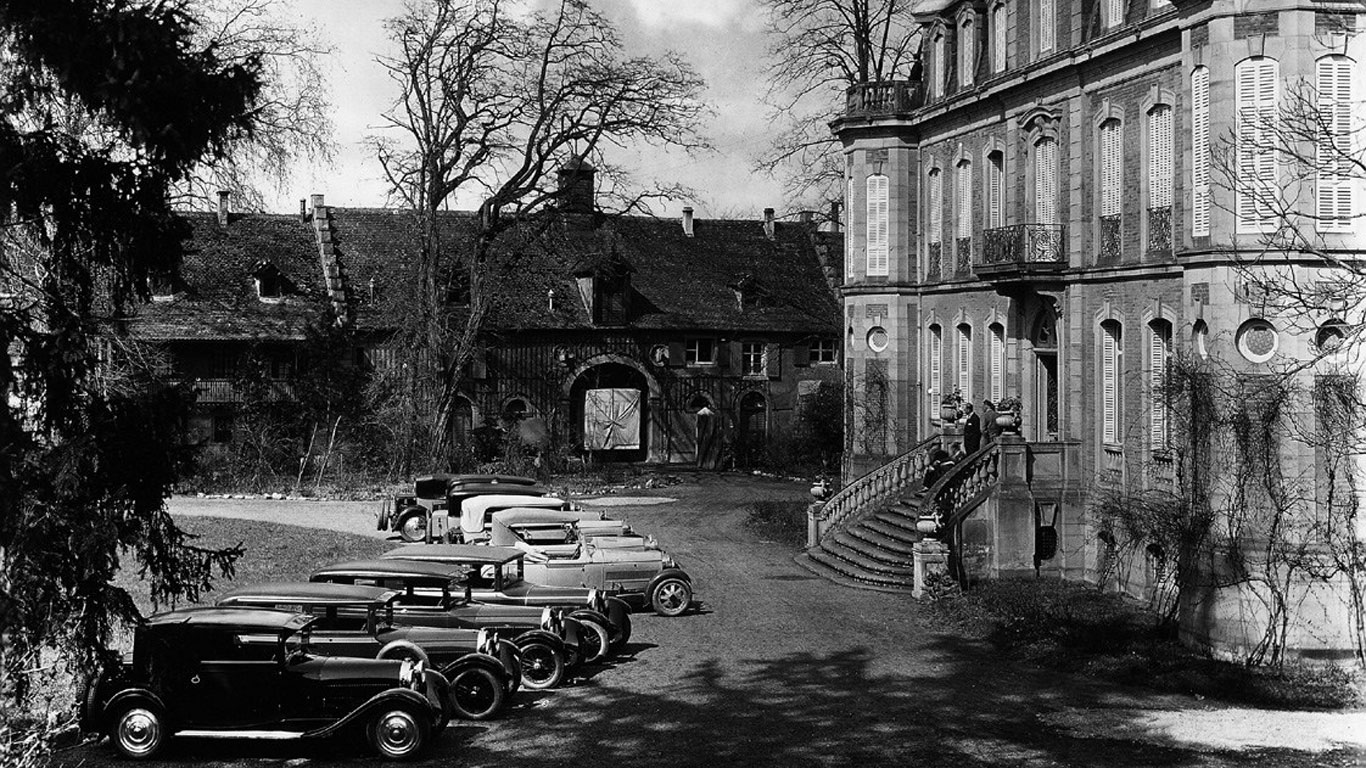
In 1962, the Schlumpf brothers used Hugh Conway’s list of Bugatti owners to acquire 50 cars, before snapping up a further 18 cars owned by the Bugatti family. This collection included the Royale owned by Ettore himself.
In 1963, Bugatti was bought by Hispano-Suiza, which renamed the company Messier-Bugatti. Twenty-four years later, Romano Artioli purchased the rights to the trademark and company and moved Bugatti to Campogalliano, near Modena.
Bugatti EB 110
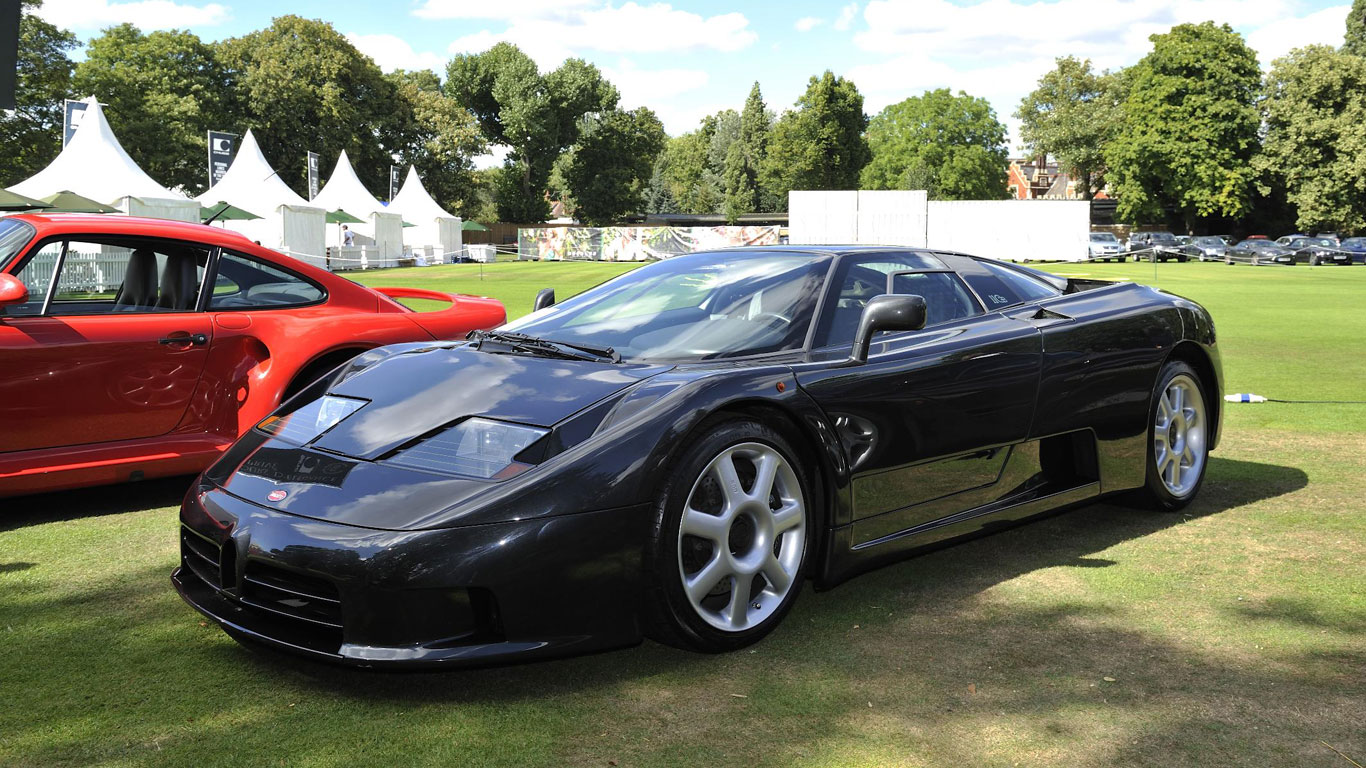
In 1991, exactly 110 years after the birth of Ettore Bugatti, the company was back. The EB 110 was as innovative and evocative as its forebears, boasting a quad-turbocharged V12 engine, permanent four-wheel drive and the world’s first carbonfibre chassis.
It also shared something in common with the Type 41 Royale, arriving at a time when the world was plunged into a deep recession. It meant that few people could afford to pay the extravagant price tag.
Bugatti EB 110 SS
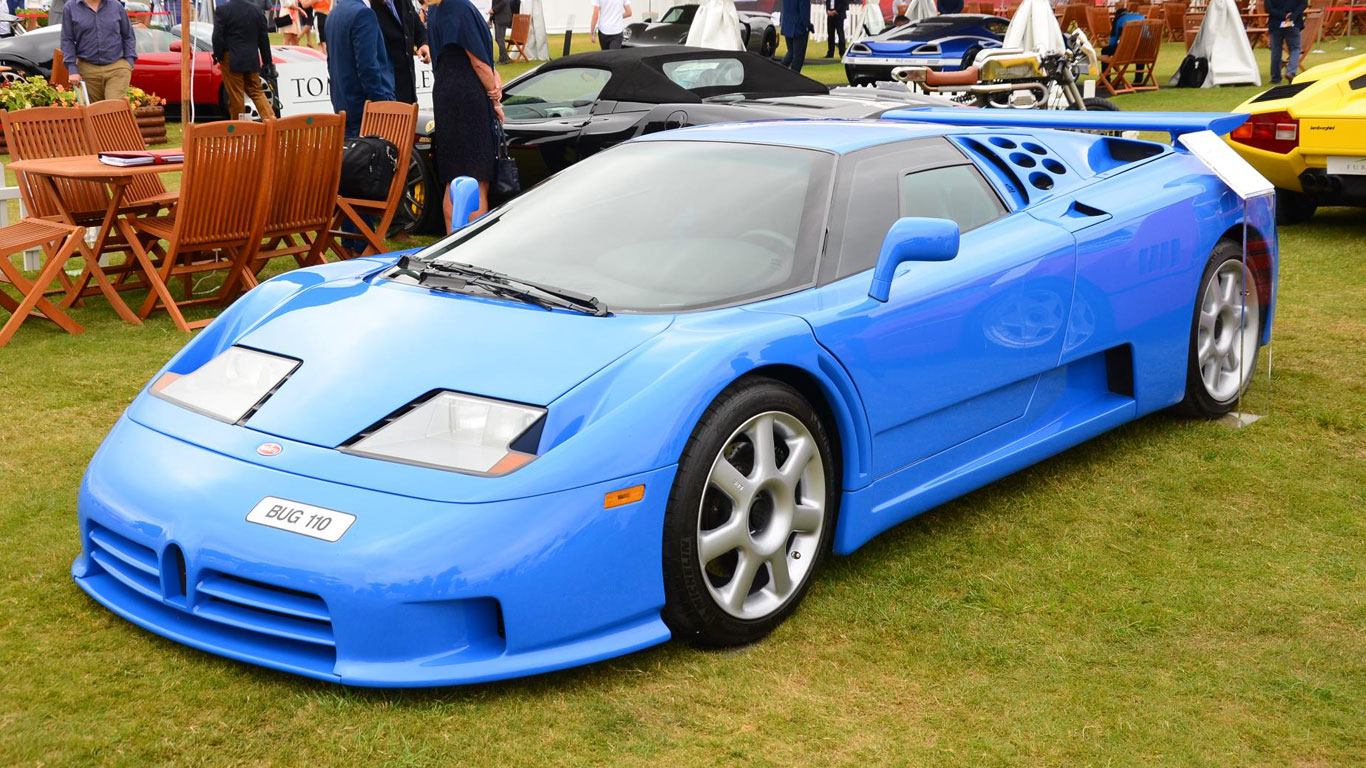
Predictably, Romano Artioli’s vision of a new future for Bugatti failed to materialise and the company was declared bankrupt. But that wasn’t before Bugatti was able to build the Super Sport, the ultimate version of the EB 110.
In this guise, the EB 110 SS could achieve a top speed of 195mph, so it’s little wonder that Michael Schumacher purchased a yellow car in 1994. He kept it until 2003.
Bugatti EB 118
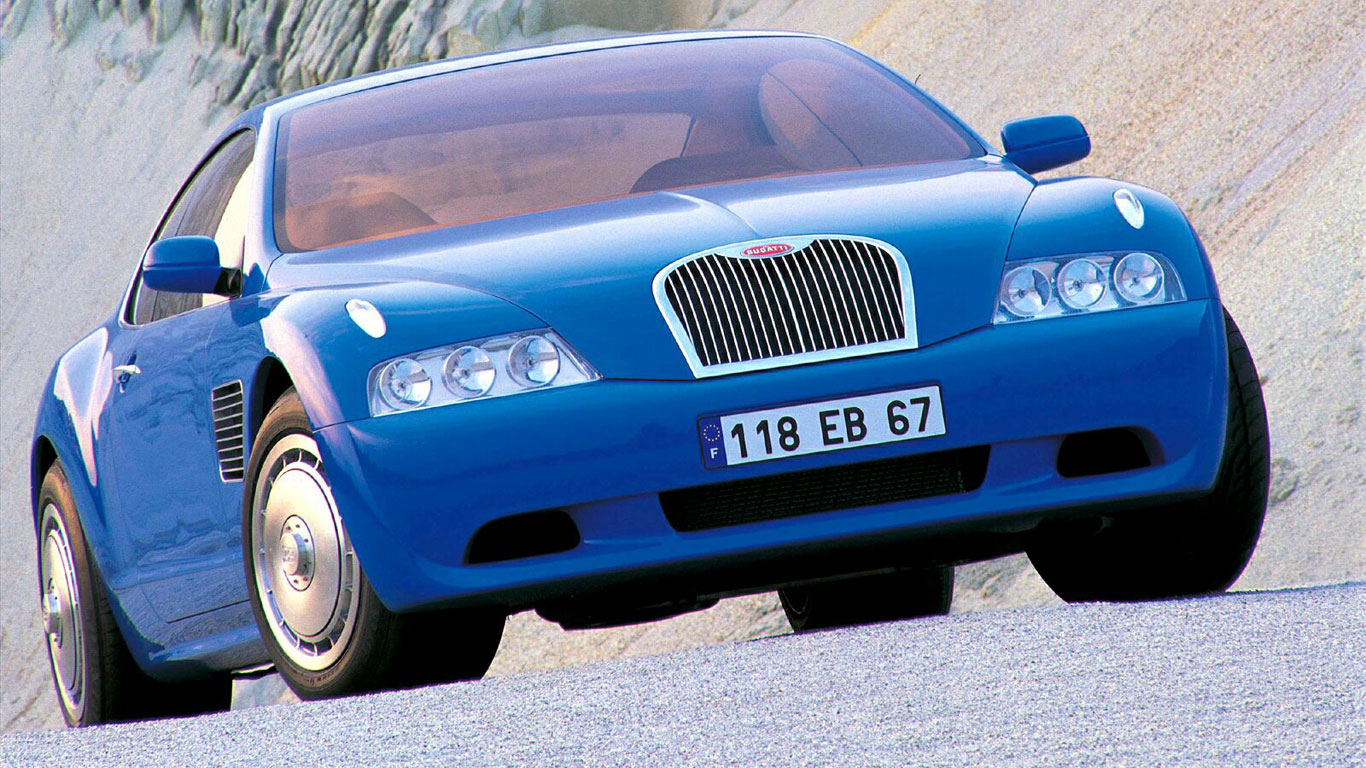
With Bugatti Automobili filing for bankruptcy in 1995, it was left to German sports car manufacturer, Dauer Racing GmbH to pick up the pieces. Production of the EB 110 continued, with a further 10 models completed.
Volkswagen acquired the rights to the brand in 1998 and unveiled the EB 118 in October of that year. The 18-cylinder, Giorgetto Giugiaro-designed four-seat coupe paved the way for one of the most famous cars of the new millennium.
Bugatti EB 18.4 ‘Veyron’
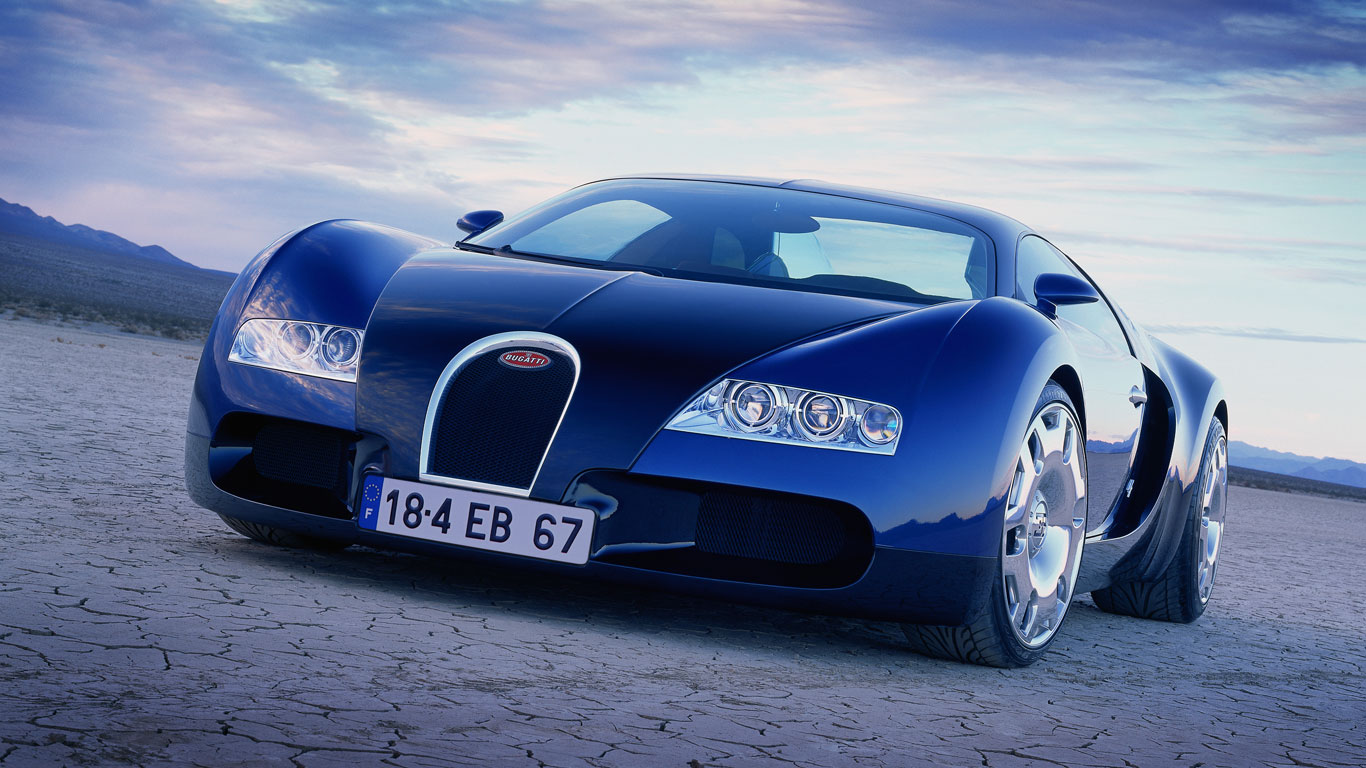
Three more design studies followed in 1999: the EB 218 four-door saloon, the EB 18.3 and, finally, the EB 18.4 (pictured).
This was the closest hint yet that a formidable hypercar was waiting in the wings. In 2000, the 16.4 concept arrived, based on the 18.4 and powered by a 16-cylinder, 630hp W engine. It was named after the French racing driver, Pierre Veyron.
Bugatti Veyron 16.4
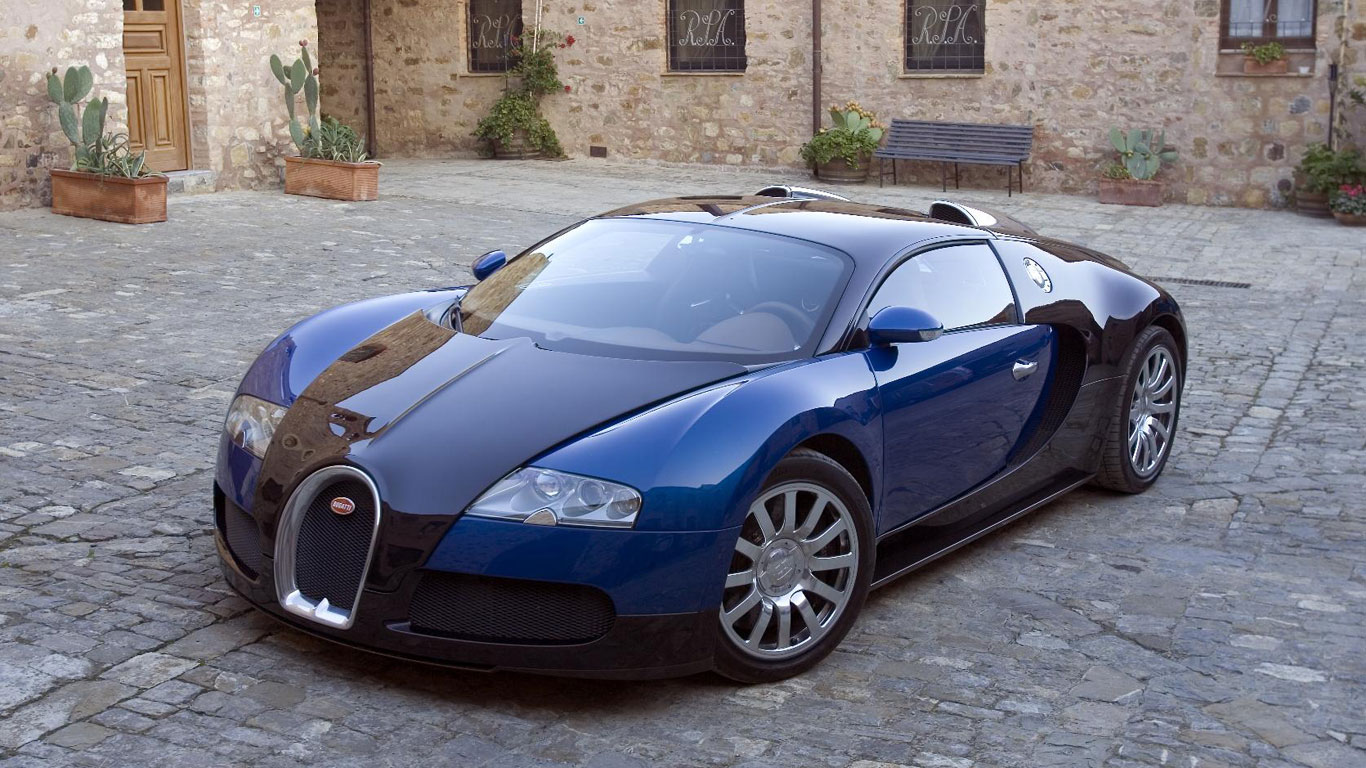
In 2001, Volkswagen announced that it would be putting a 1,001hp hypercar into production and that manufacturing would take place at Bugatti’s rightful home in Alsace. To this end, the company refurbished the traditional company’s HQ in Molsheim, calling it ‘The Studio’.
Production of the Veyron 16.4 commenced in 2005, with the new Bugatti pushing the boundaries of what was expected from a modern supercar. With a top speed of 400km/h and a 0-62mph time of sub three seconds, the Veyron was a true game-changer.
Bugatti Veyron 16.4 Grand Sport
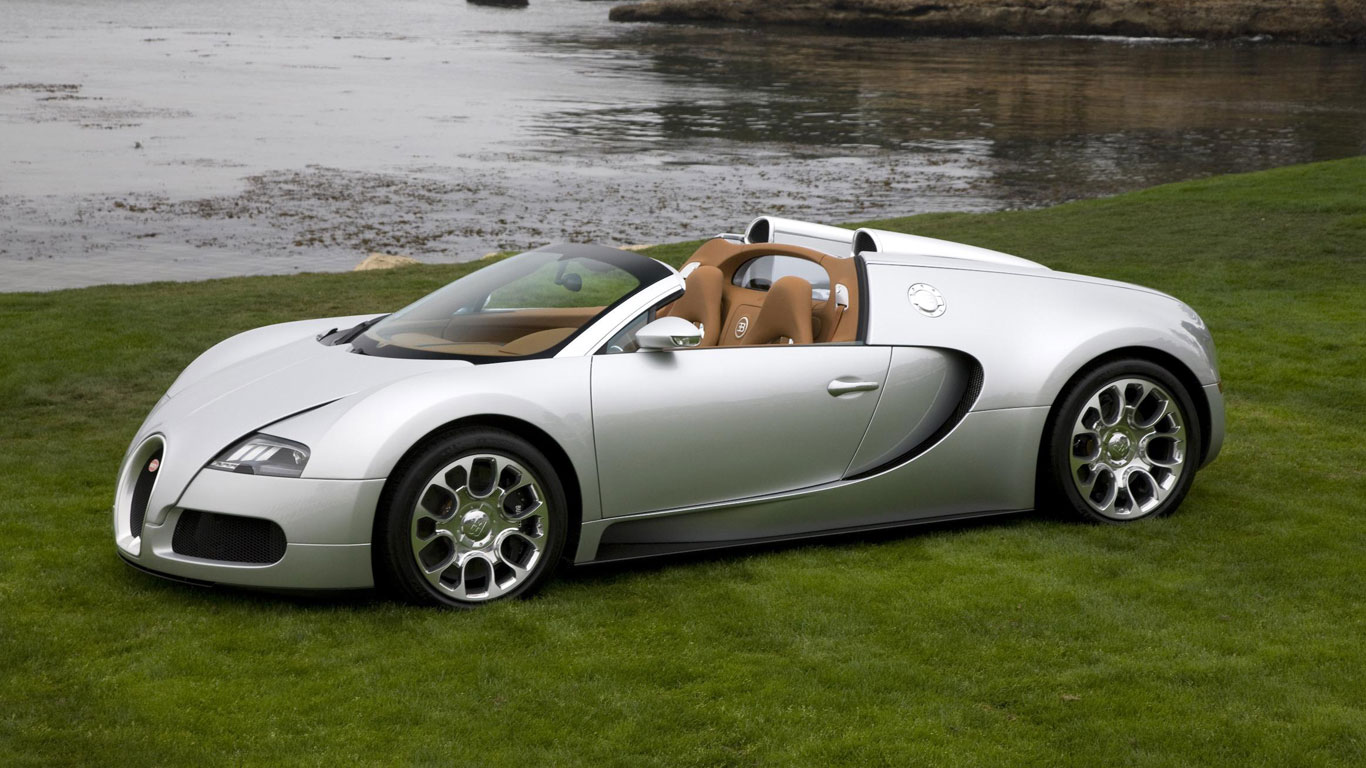
In 2008, Bugatti chose the Concours d’Elegance at Pebble Beach to launch the Veyron 16.4 Grand Sport. Chassis number one was sold for $3.2 million.
To mark the centenary of Bugatti in 2009, the company unveiled four ‘Centenaire’ models, paying tribute to the Type 35. The cars were presented in the colours of the countries that dominated motorsport of the era: blue for France, red for Italy, green for Britain and white for Germany.
Bugatti 16 C Galibier concept
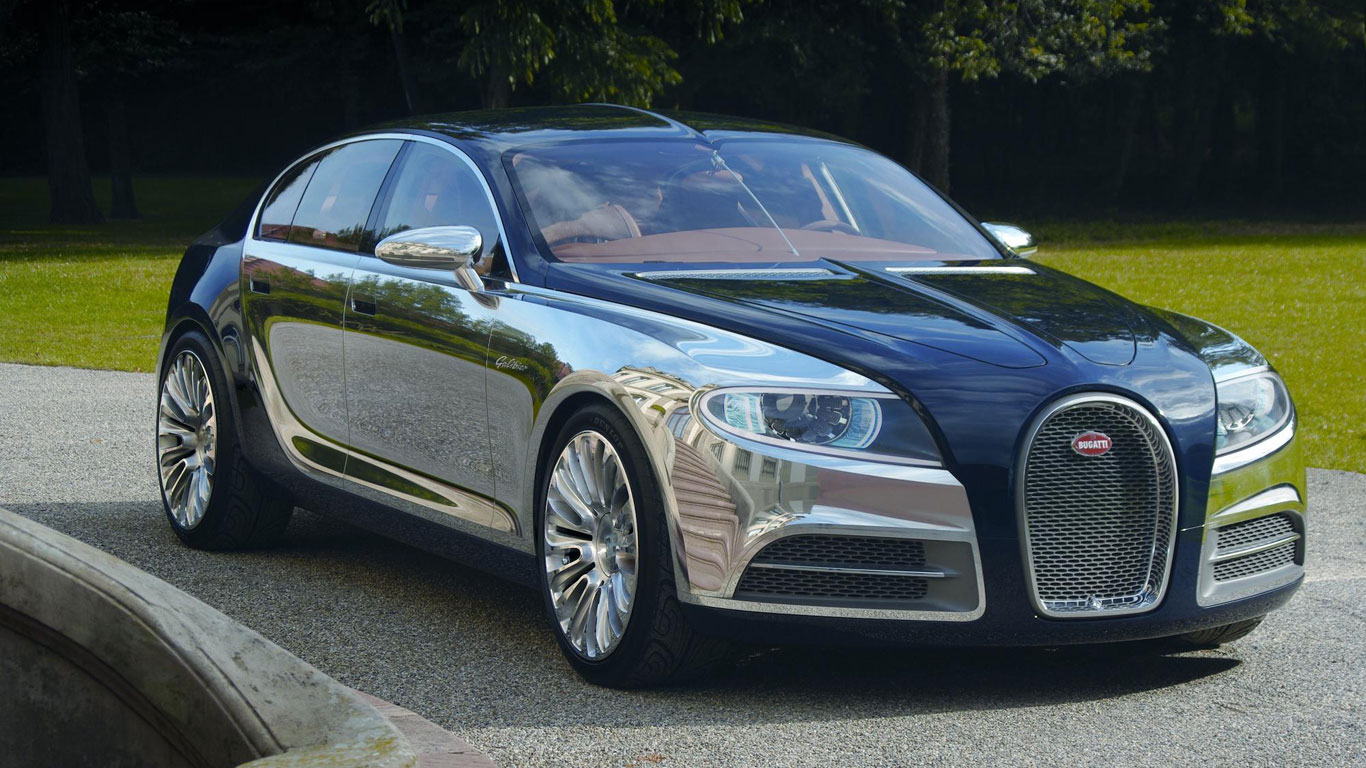
Bugatti unveiled the 16 C Galibier concept with a promise to build “the most exclusive, elegant, and powerful four-door automobile in the world”. Sounds a little like the Type 41 Royale, then?
It name stems from a complex Alpine pass and a version of the Type 57. Sadly, we’re yet to see a modern-day Bugatti four-door…
Bugatti Veyron 16.4 Super Sport
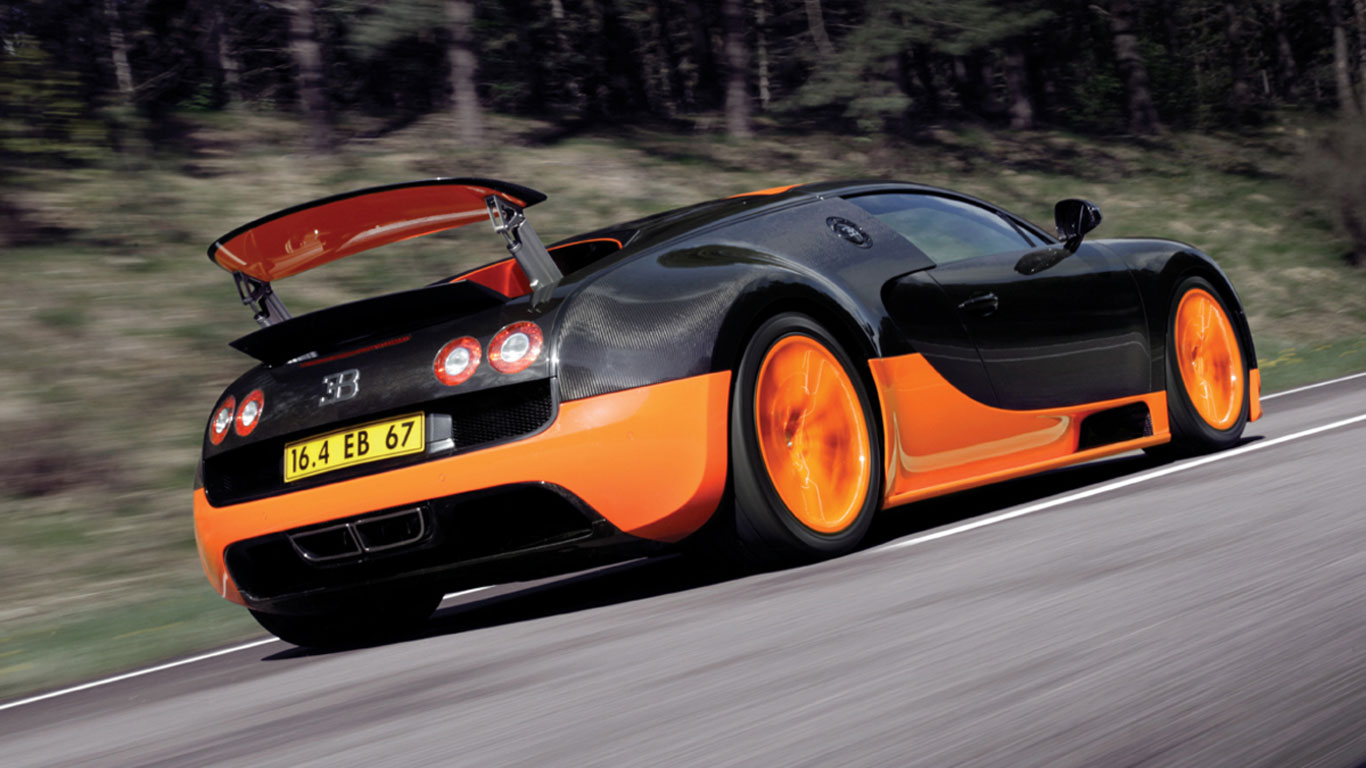
That’s because Bugatti was focused on pace rather than grace. In June 2010, the Bugatti Veyron 16.4 Super Sport broke the speed record for production cars, achieving a top speed of 431.072km/h (267.86mph).
The Super Sport develops 1,200hp and remains the fastest production car on the planet.
Bugatti Veyron 16.4 Grand Sport Vitesse
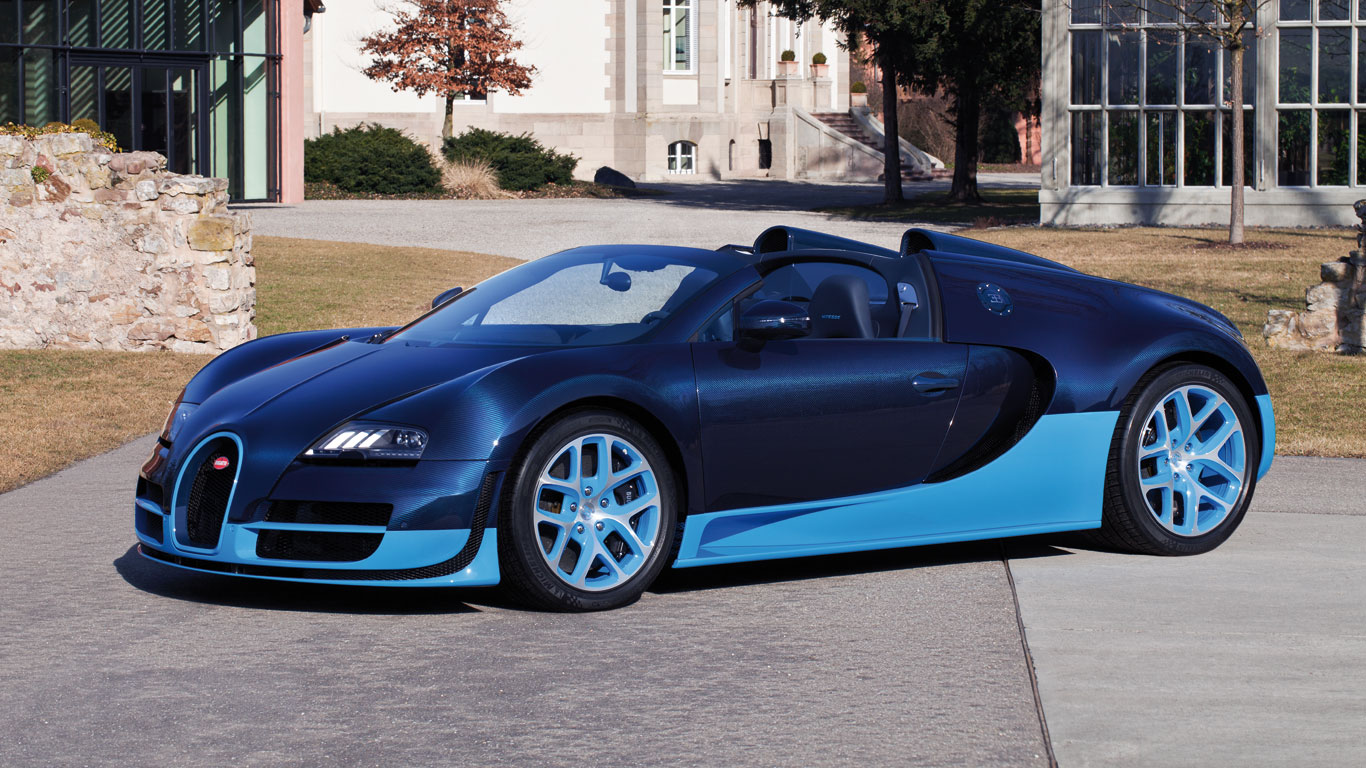
The Veyron 16.4 Grand Sport Vitesse was unveiled at the 2012 Geneva Motor Show and is essentially an open-top version of the Super Sport. At 408.84km/h (254.04mph) it is the official fastest production roadster in the world.
When news of dieselgate broke, it was thought that development of future Bugatti models might be halted…
Bugatti Chiron
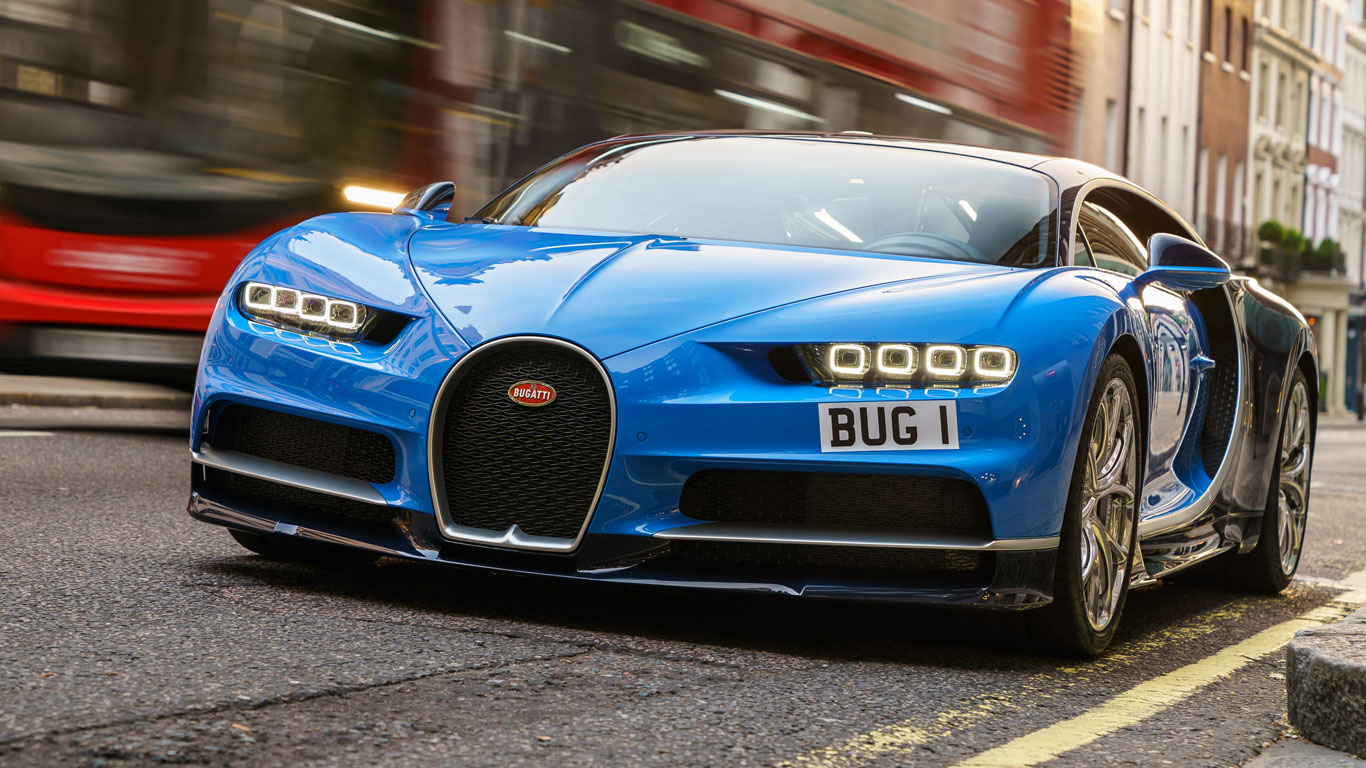
At the 2016 Geneva Motor Show, Bugatti unveiled the Chiron: the world’s first production car with 1,500hp. “Ready for a new world speed record”, said Bugatti when the firm released the performance figures. Even at a base price of €2.4 million, Bugatti had secured advance orders for a third of the total production of 500 units.
In June 2017, Bugatti London welcomed the first Chiron customer car in the UK, painted in the launch colours of the world premiere Chiron. Early in the year, Bugatti announced that half of the total series had already found a buyer – even without test drives.
Bugatti Chiron Sport
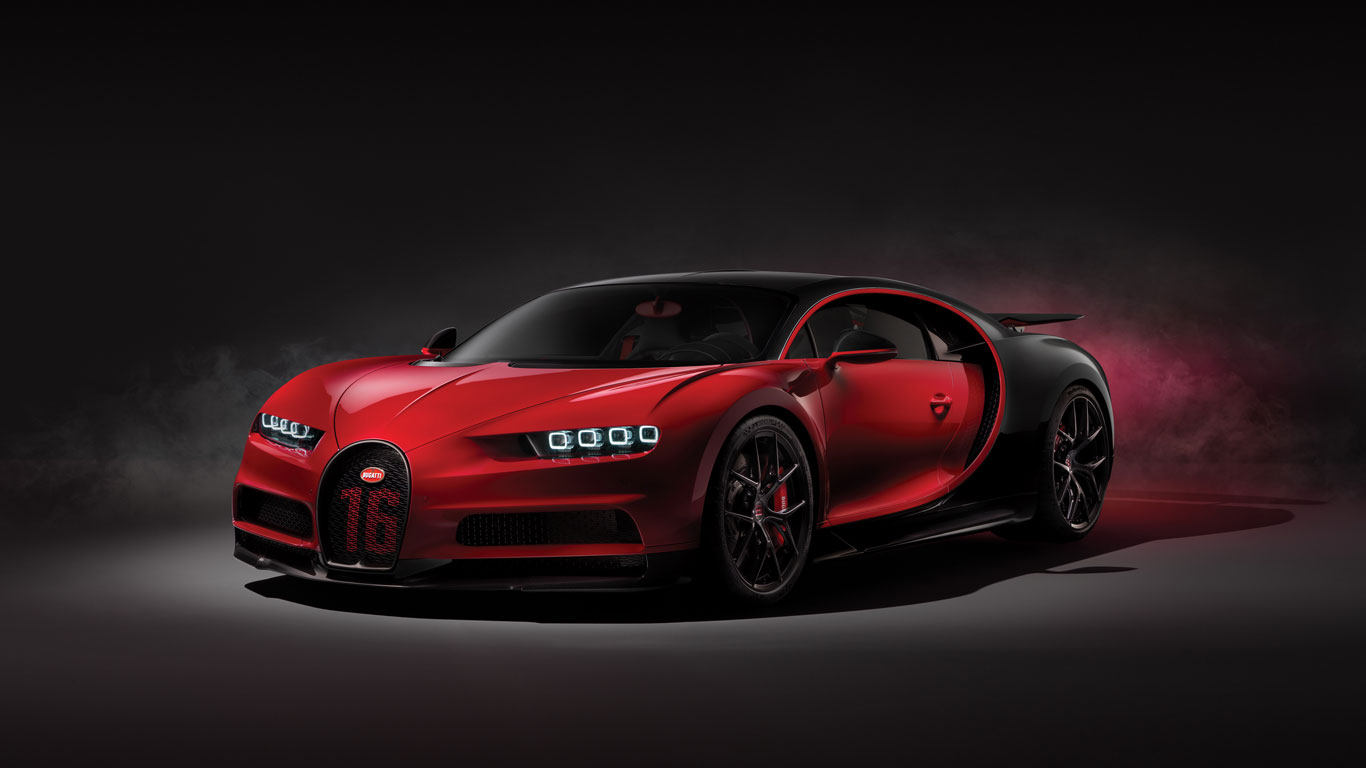
Two years after the launch of the original Chiron, Bugatti followed it up with the Chiron Sport. It retains the 1,500hp powertrain, but Bugatti has developed a dynamic handling package and reduced the weight of the Chiron by 18kg to deliver higher cornering speeds and greater agility.
Even without any extra power, the Chiron Sport can lap the Nardo handling circuit a full five seconds faster than the ‘standard’ Chiron. The Chiron Sport is distinguished by a new wheel design and four-pipe exhaust deflector, and is the first car to boast carbon fibre windscreen wipers. That’s one for your next pub quiz.
The 100th Chiron

In March 2018, Bugatti celebrated the production and delivery of the 100th Chiron. Its lucky owner opted for a striking combination of dark blue carbon in a matt finish and a red side line. The owner paid a cool €2.85 million (£2.45 million) for the landmark Chiron.
Stephan Winkelmann, Bugatti president, said: “I find the 100th Chiron especially pleasing. It is dynamic and elegant in equal measure. This car shows that Bugatti produces highly individualised masterpieces of automobile craftsmanship that are simply unparalleled.”
Bugatti Divo
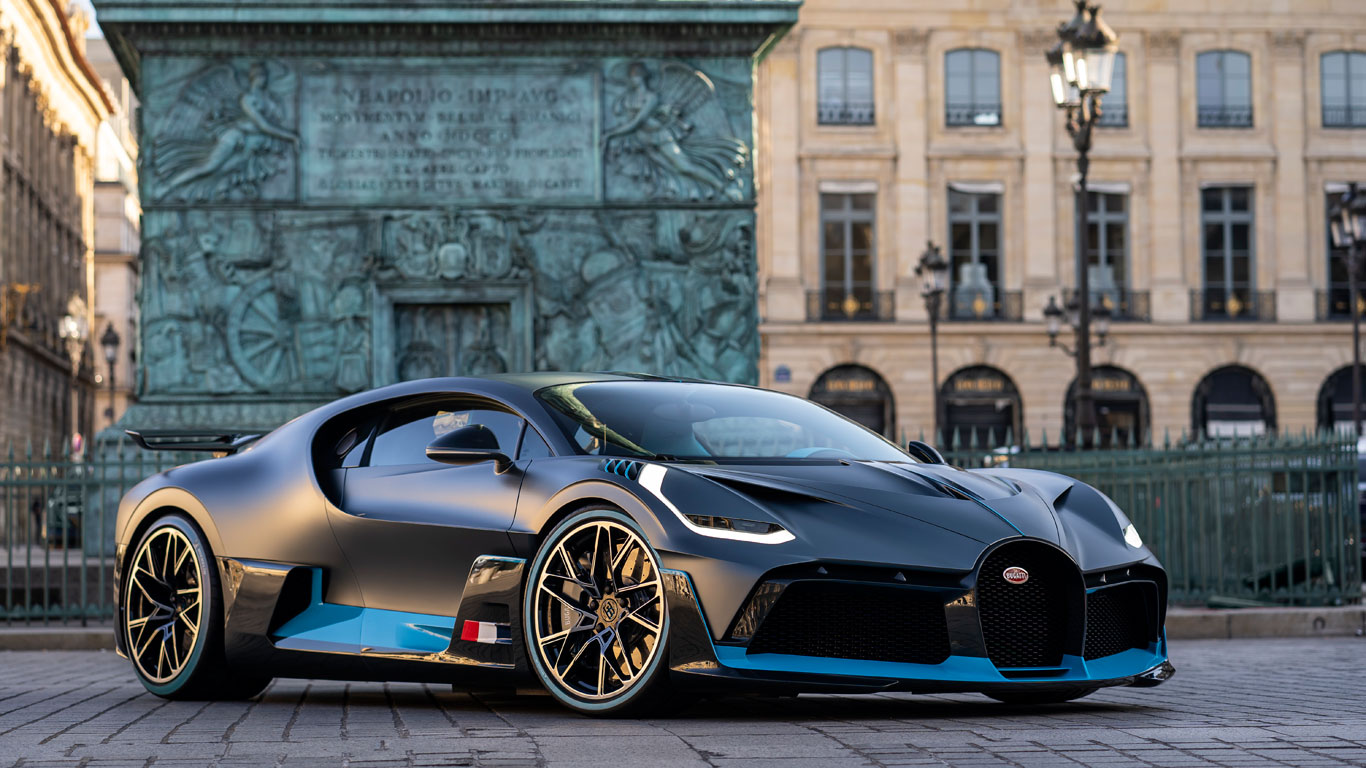
Even if you could afford the €5 million (£4.3 million) price tag, you couldn’t get your hands on the Bugatti Divo. Not unless you were one of the 40 customers selected by Bugatti. By the time the world got wind of the Divo, each one had already been spoken for.
Again, the power output is the same as the Chiron, but the Divo is 35kg lighter and has 90kg more downforce than its sibling. The result is that this stiffer, lighter, more hardcore and ultra-exclusive Bug’ can lap the Nardo circuit eight seconds faster than the Chiron and can hit a top speed of 236mph.
The Lego Chiron
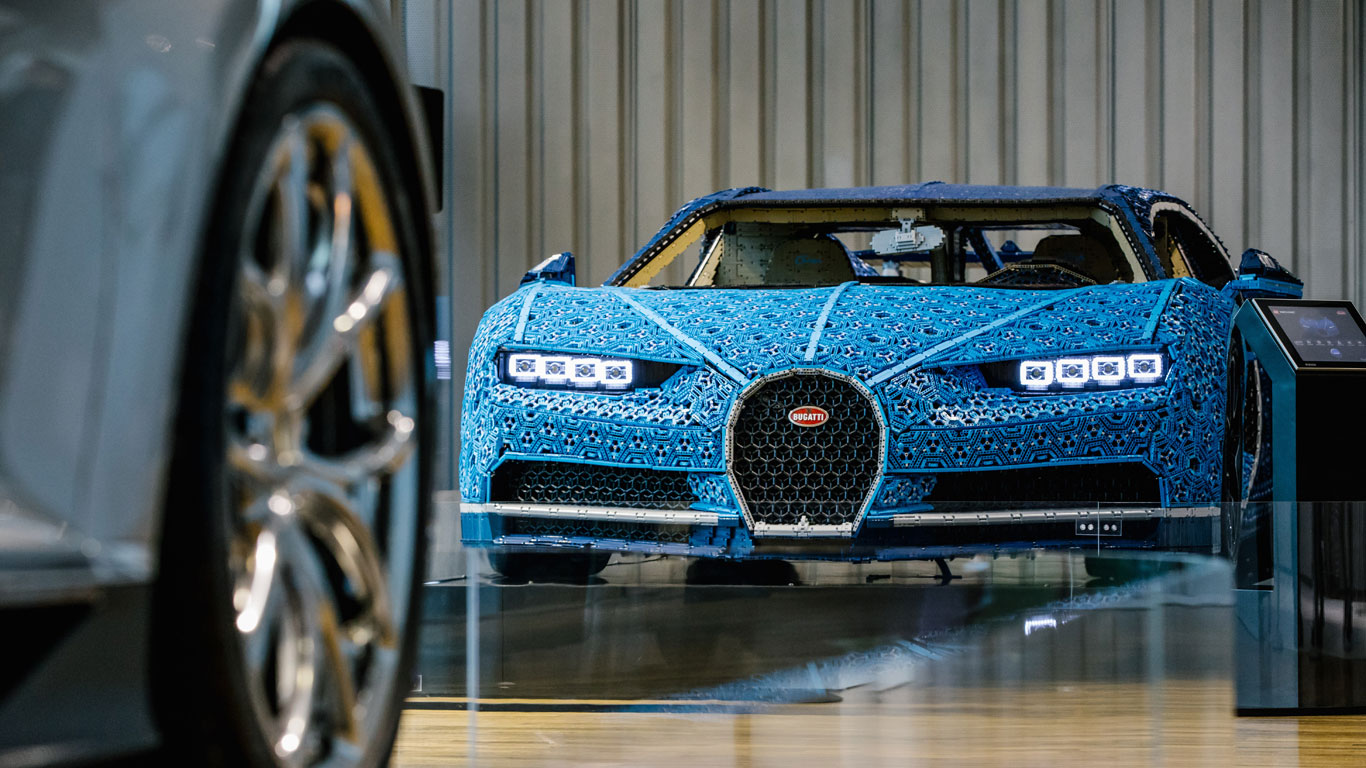
In the summer of 2018, Bugatti teamed up with Lego to produce a 1:8 scale hypercar kit comprising no fewer than 3,599 pieces. It costs a whole lot less than the real thing, and unlike the Divo, you don’t require a special invitation to buy it.
Five months later, Bugatti unveiled a driveable full-size version of the Lego Technic Chiron. The model consists of one million Lego bricks, more than 90 percent of which are Lego Technic pieces. Top speed: 20km/h (12.4mph).
Bugatti Chiron Sport ‘110 ans Bugatti’
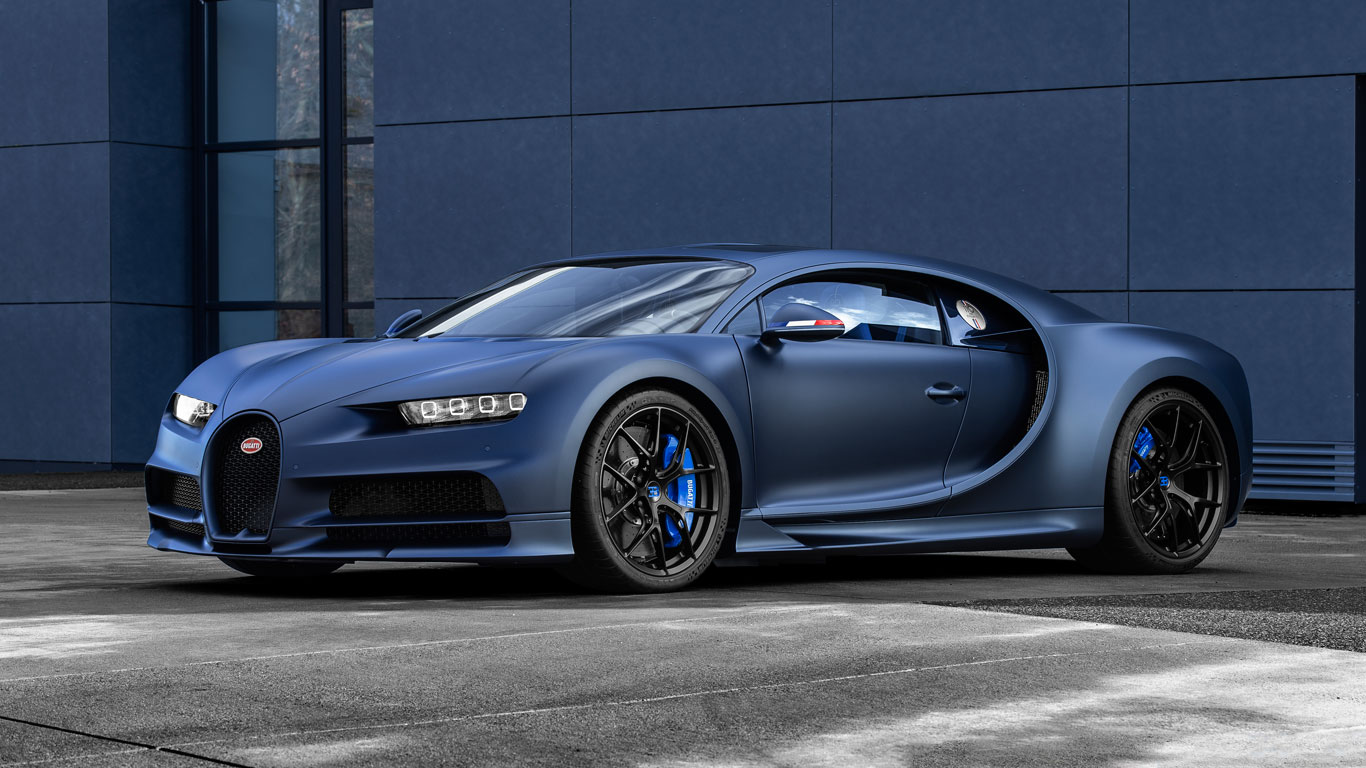
Unveiled in February 2019 and launched to the public at the 2019 Geneva Motor Show, the Chiron Sport ‘110 ans Bugatti’ celebrates 110 years of Bugatti and pays tribute to France.
The French tricolour can be found on the door mirrors, across the fuel filler cap and the underside of the rear wing. The theme continues on the inside, with the French flag embroidered on the headrests, and used to denote the ‘12 o’clock’ mark on the steering wheel.
Bugatti La Voiture Noire
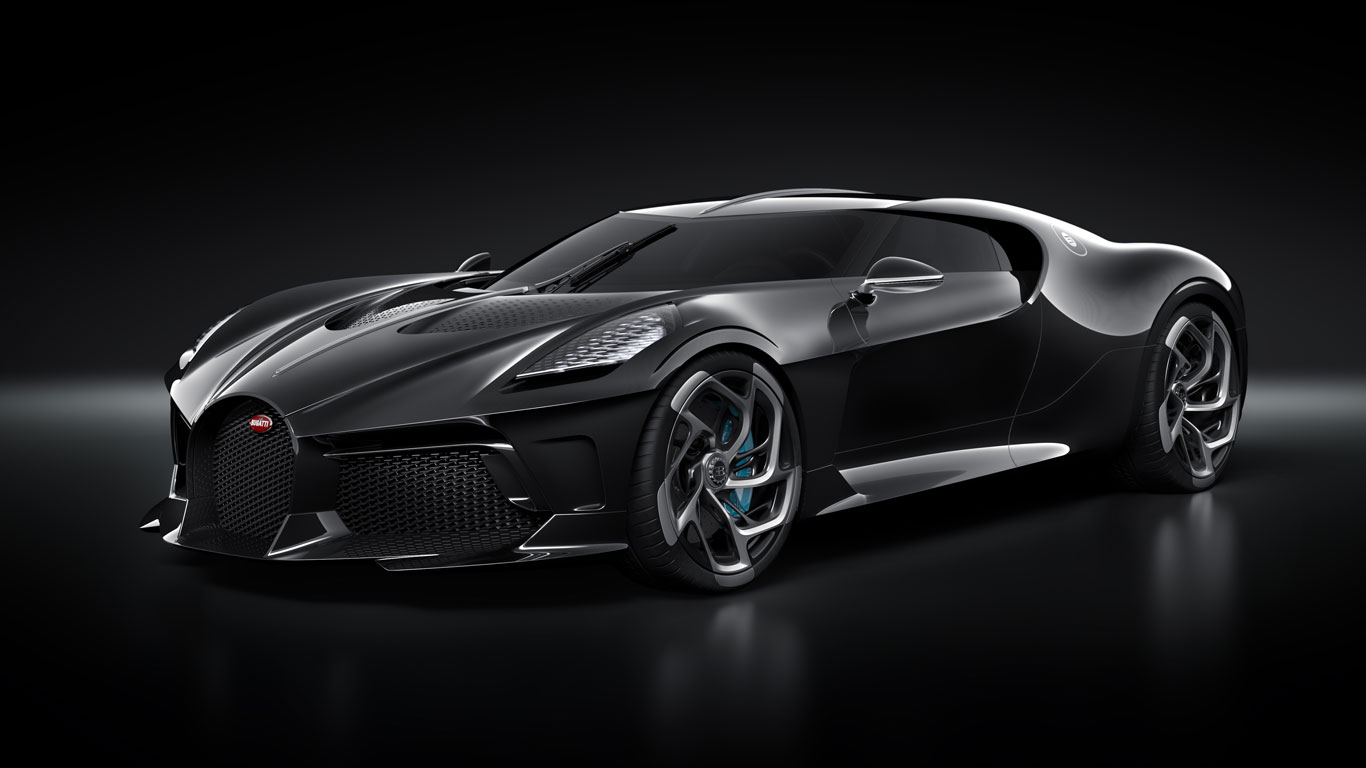
The Bugatti La Voiture Noire pays tribute to the Type 57 SC Atlantic and is the most expensive new car ever built. Once again, the Chiron is the base car, but a long sprawling nose apes the Atlantic, while there are plenty of hints of the track-prepared Divo, too.
At the back, you’ll find six exhausts and a distinctive light strip. Only one La Voiture Noire will be built, and the as-yet unknown buyer paid a jaw-dropping £12 million for the privilege of owning the most talked about car at the 2019 Geneva Motor Show.
Bugatti Baby II
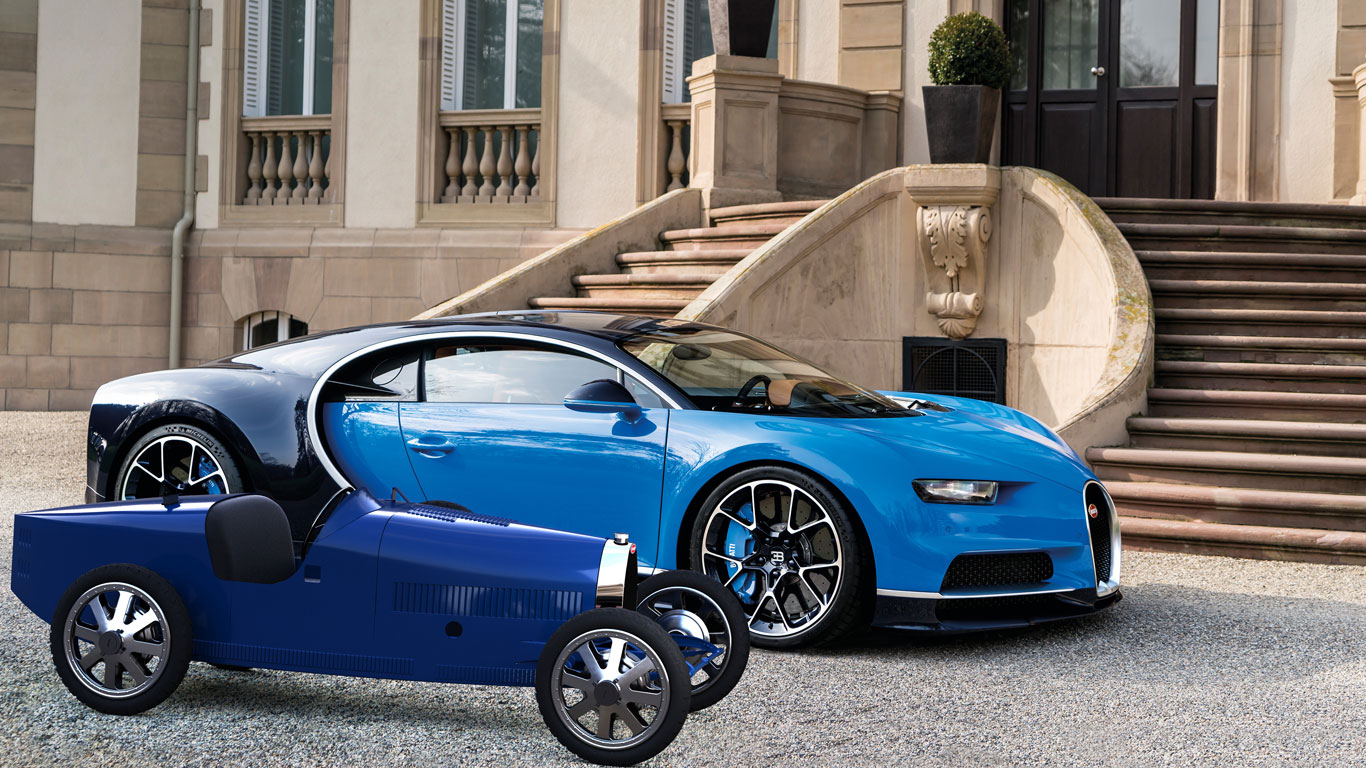
Our history ends – and the future begins – with the news that the Bugatti ‘Baby’ has returned. In 1926, Ettore Bugatti built a toy Type 35 for his youngest son Roland. Such was the response to this one-off design that Ettore was encouraged to put the ‘Baby’ into production. Around 500 were built and sold between 1927 and 1936.
To celebrate its 110th anniversary, Bugatti has unveiled a tribute to the original, and once again, just 500 will be built. Each one features a rear-wheel-drive battery-powered electric powertrain, removable lithium-ion battery packs, a limited slip differential and regenerative braking. There are two driving modes: ‘child’, with a top speed of 20km/h; and ‘adult’, with a top speed of 45km/h. The price: €30,000 (£25,000) plus local taxes.